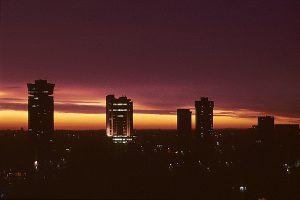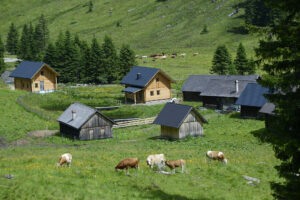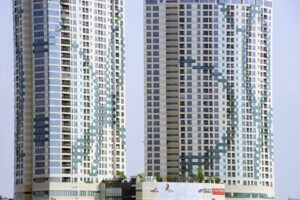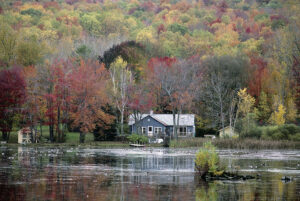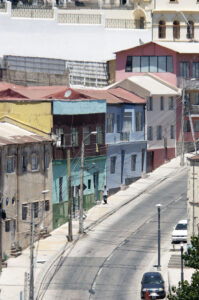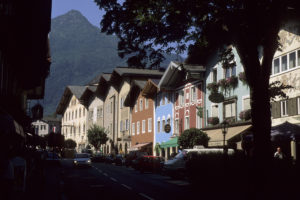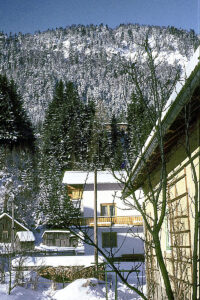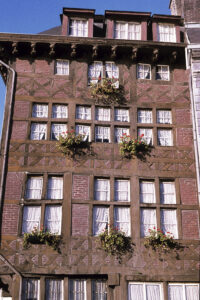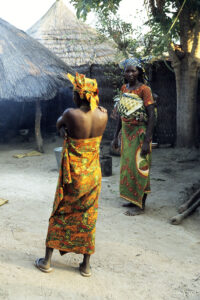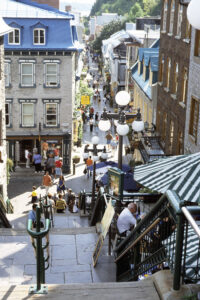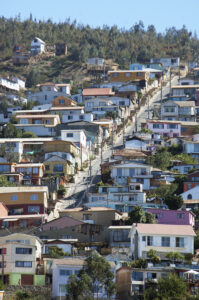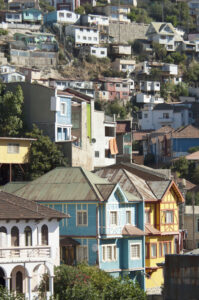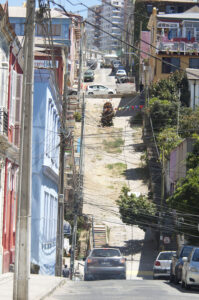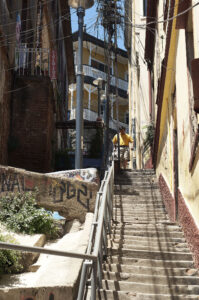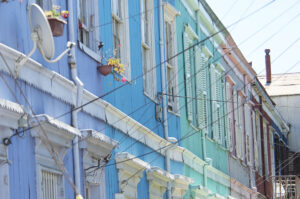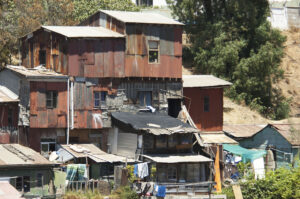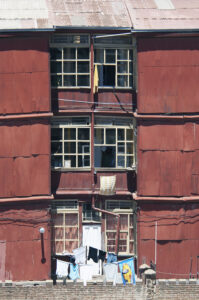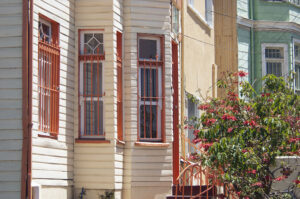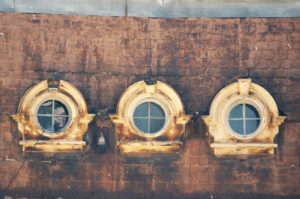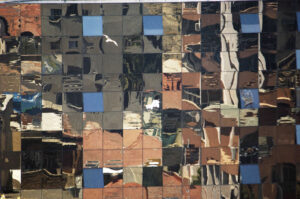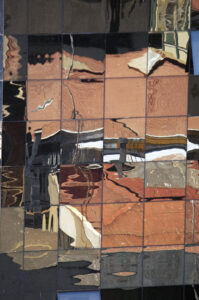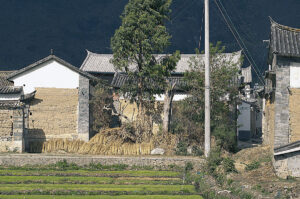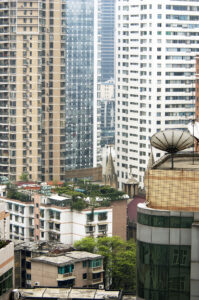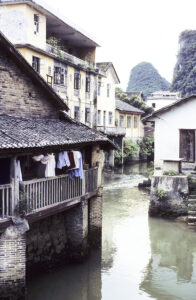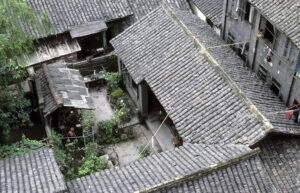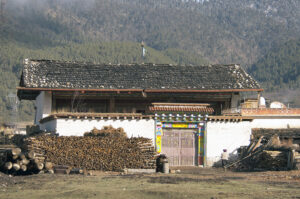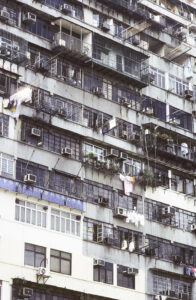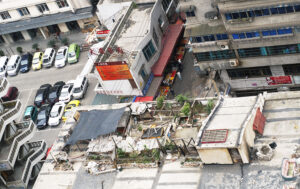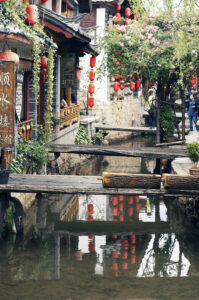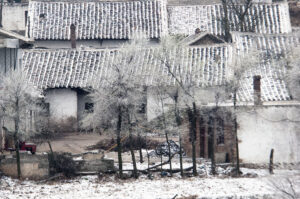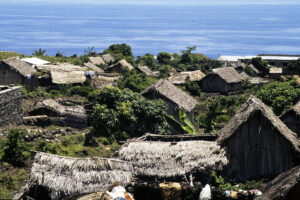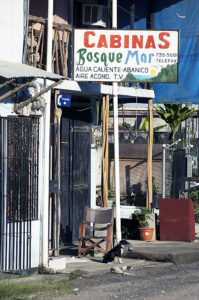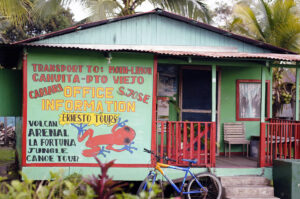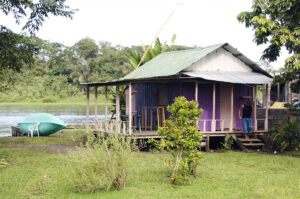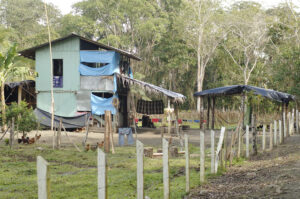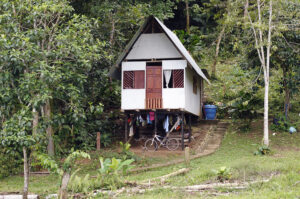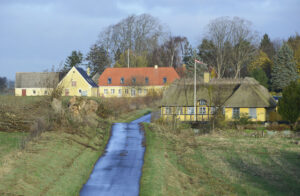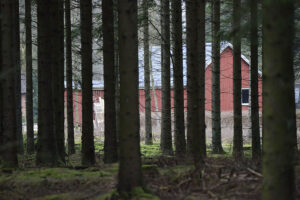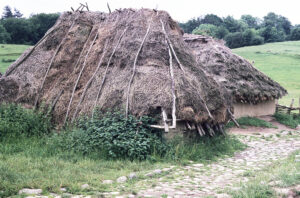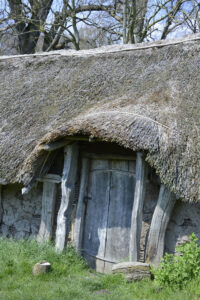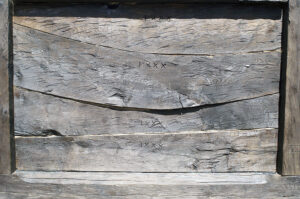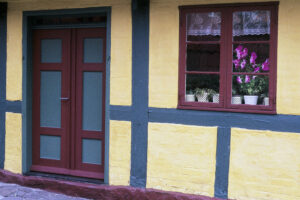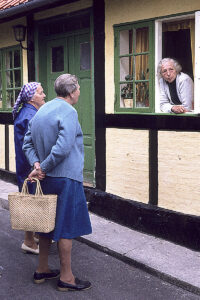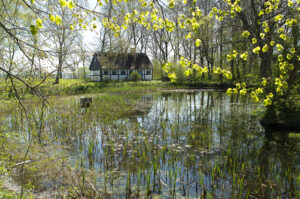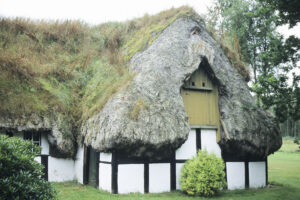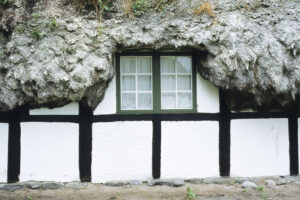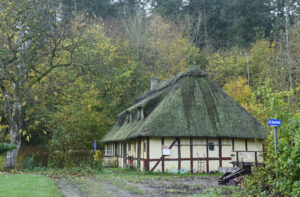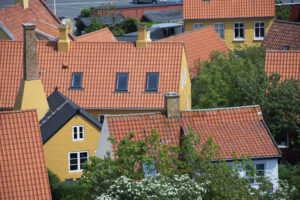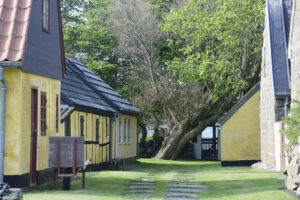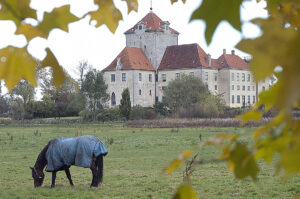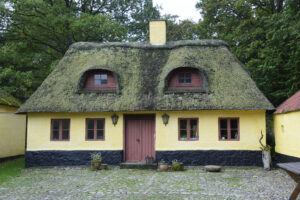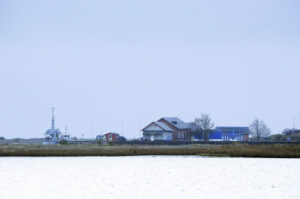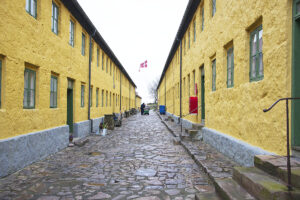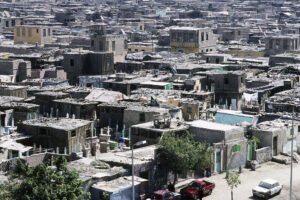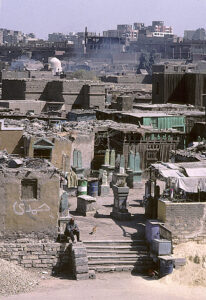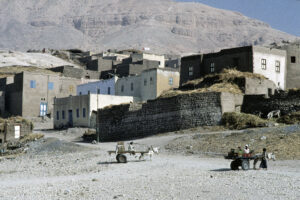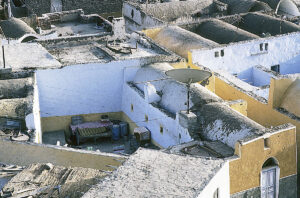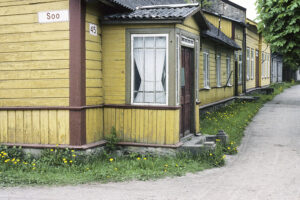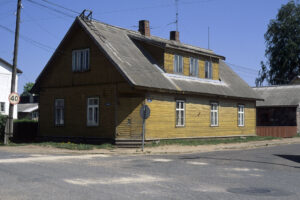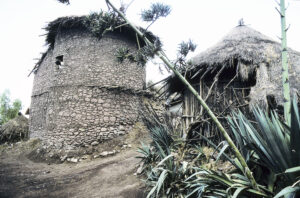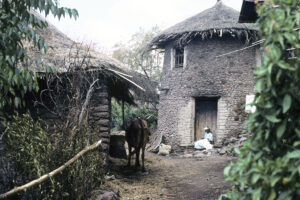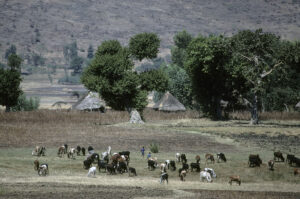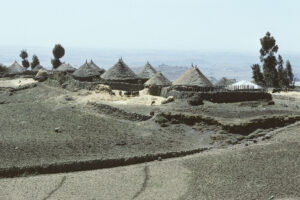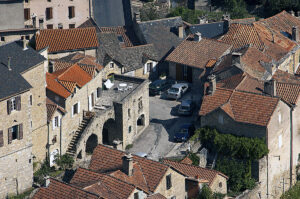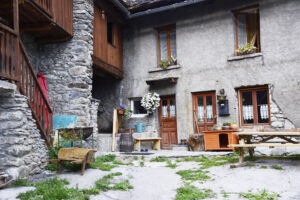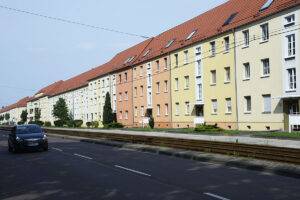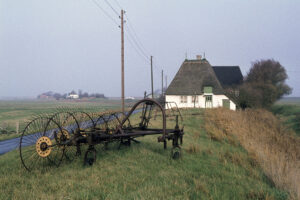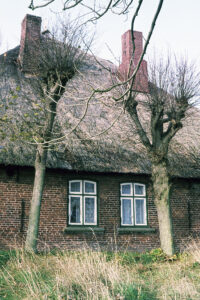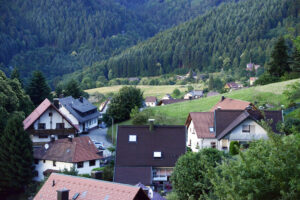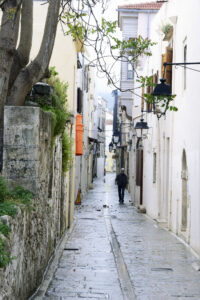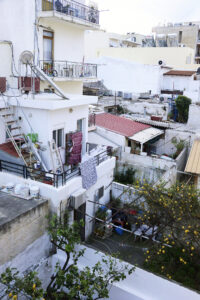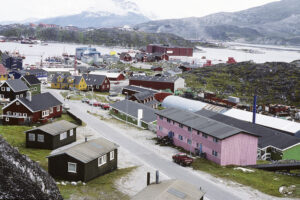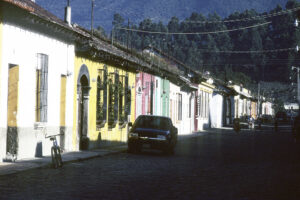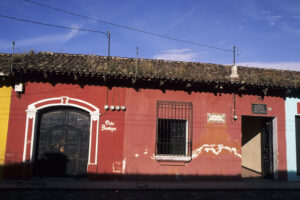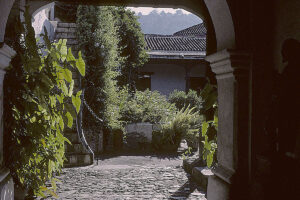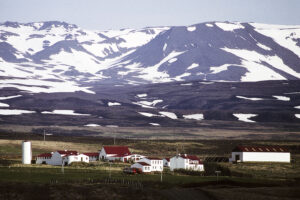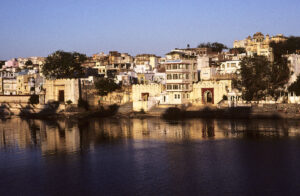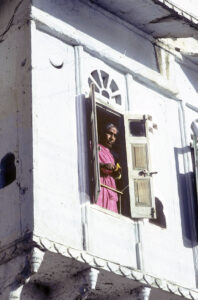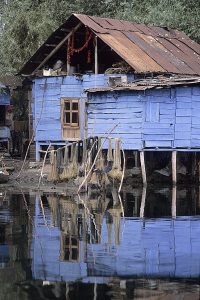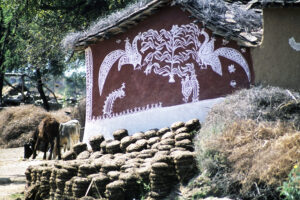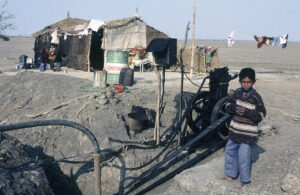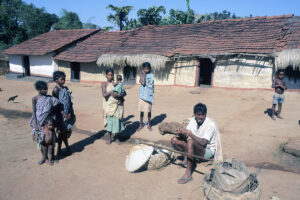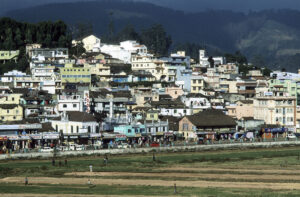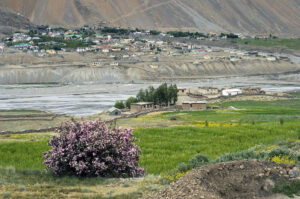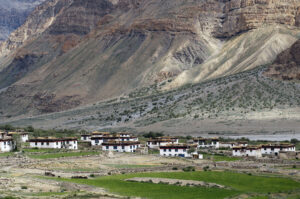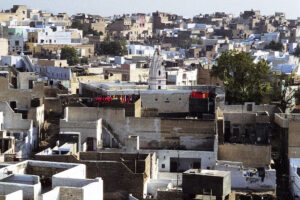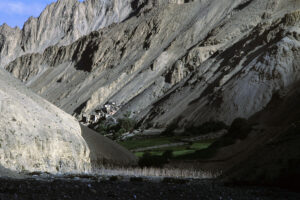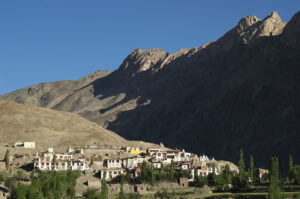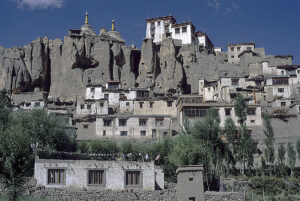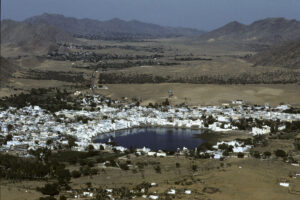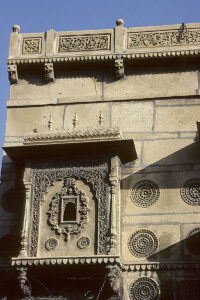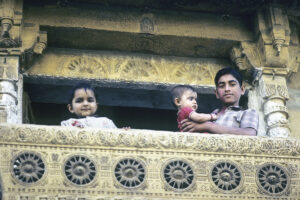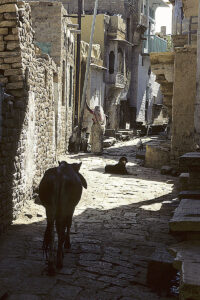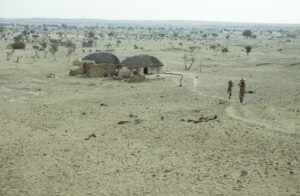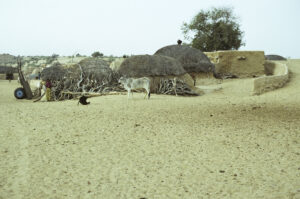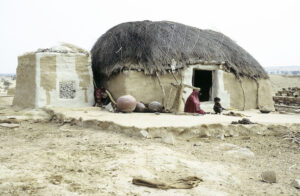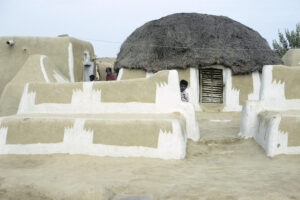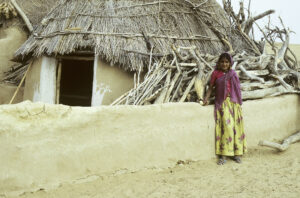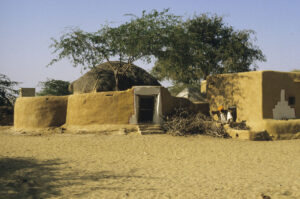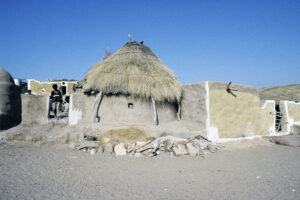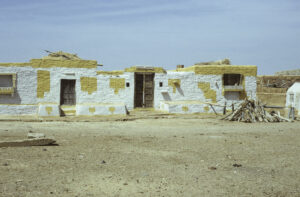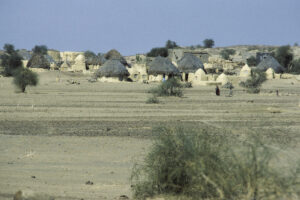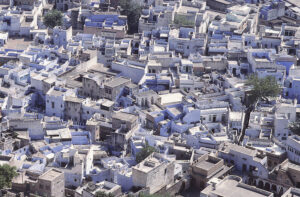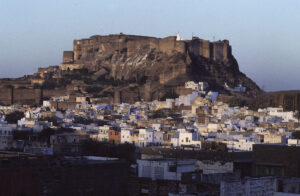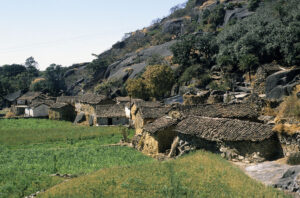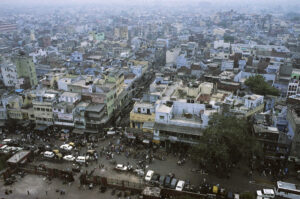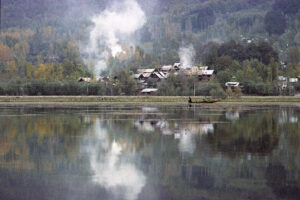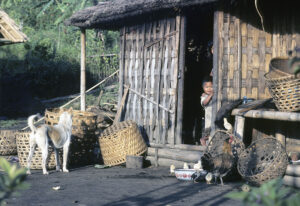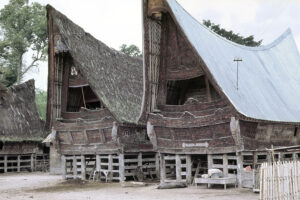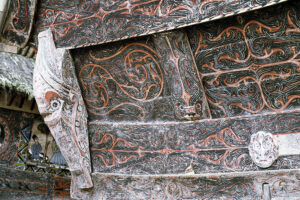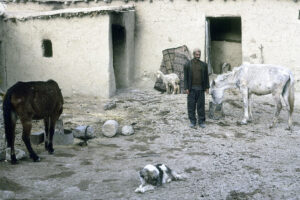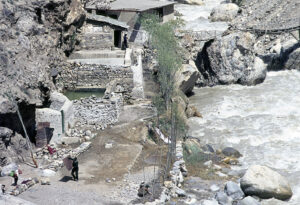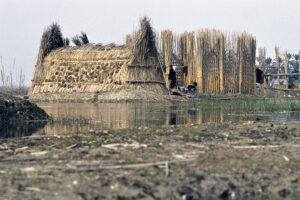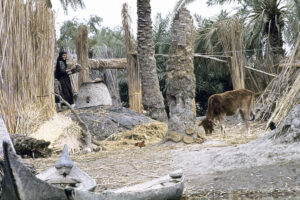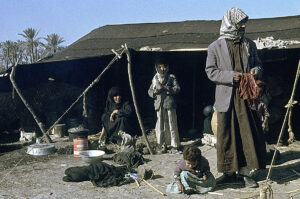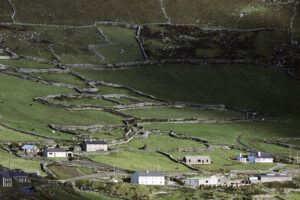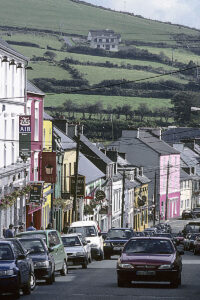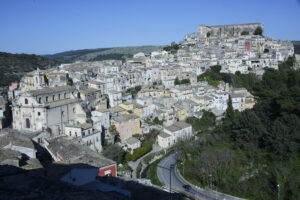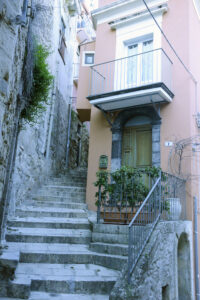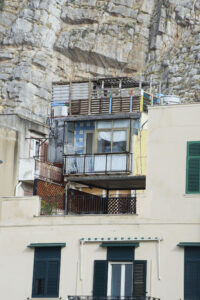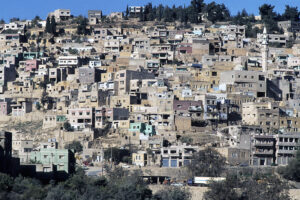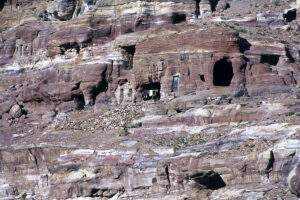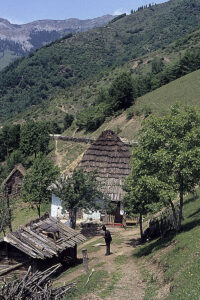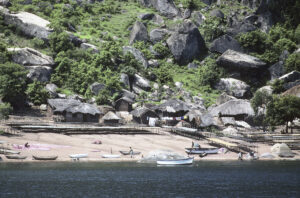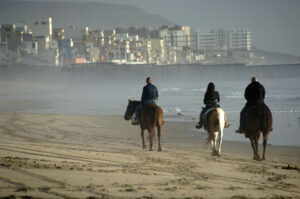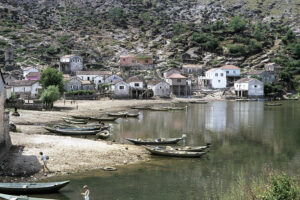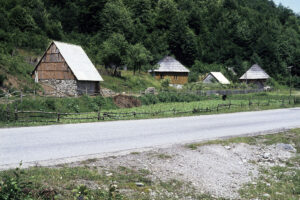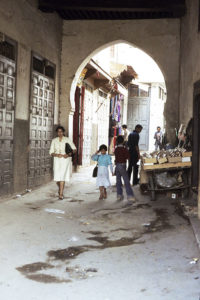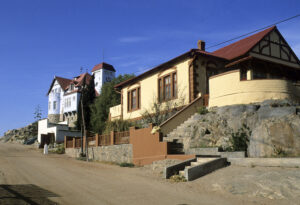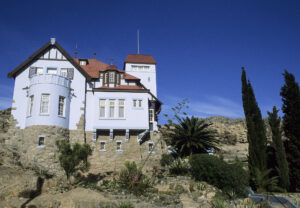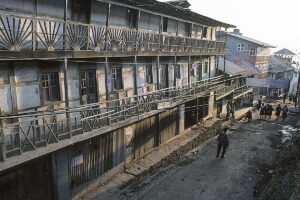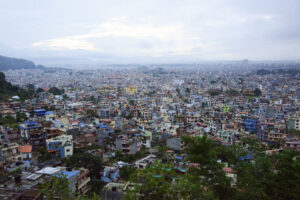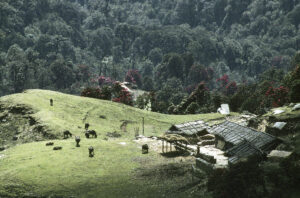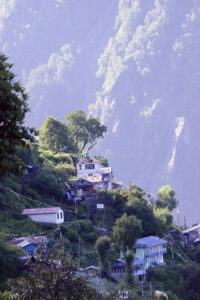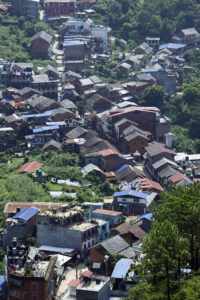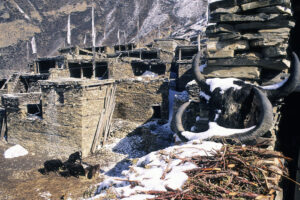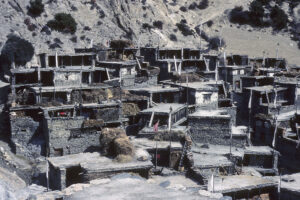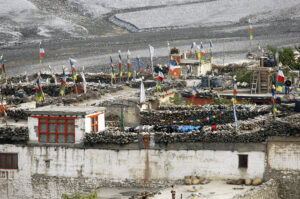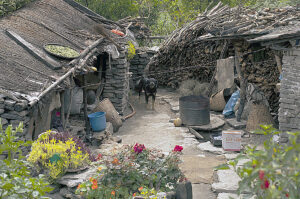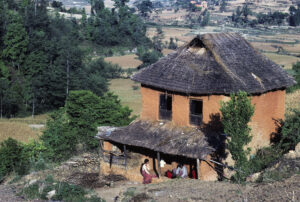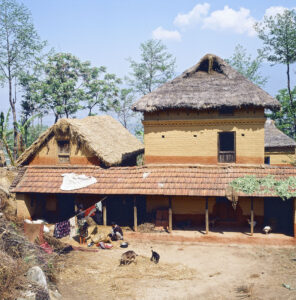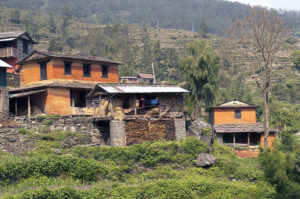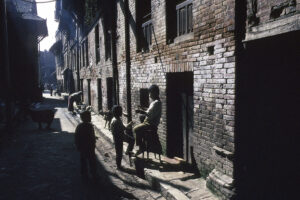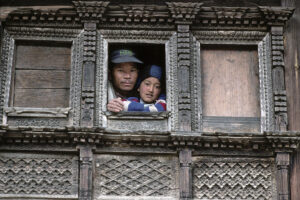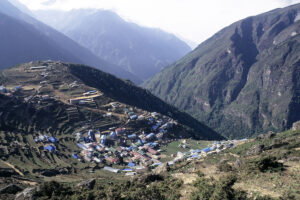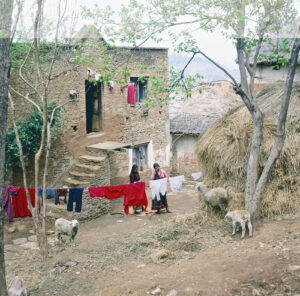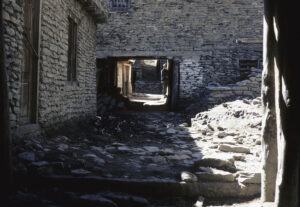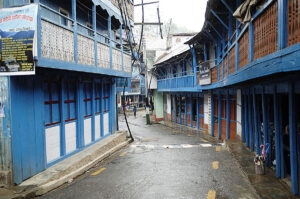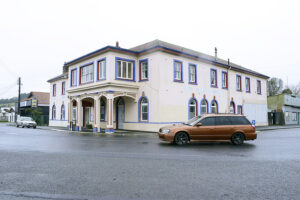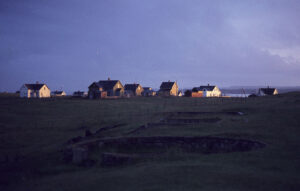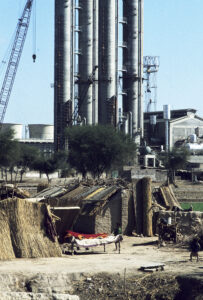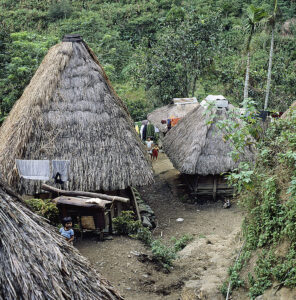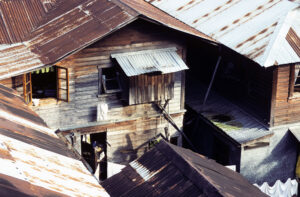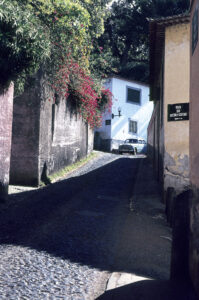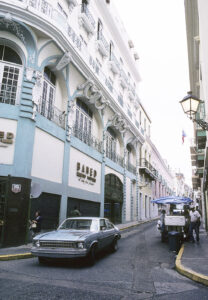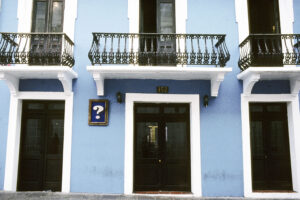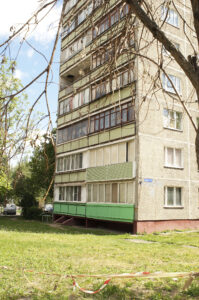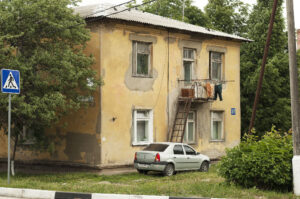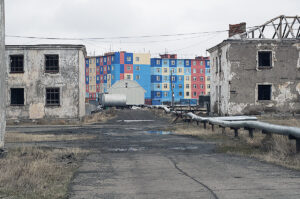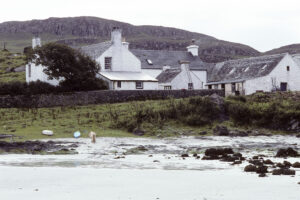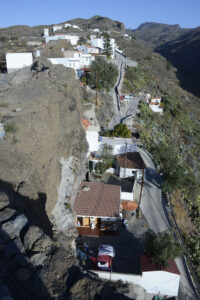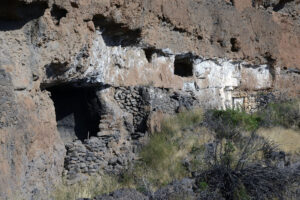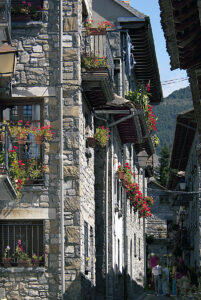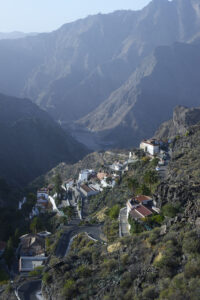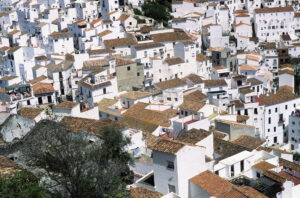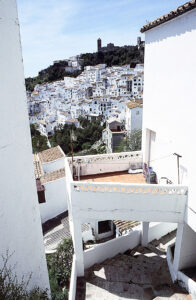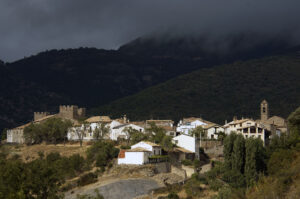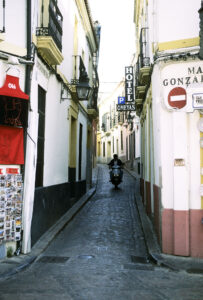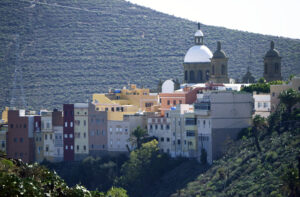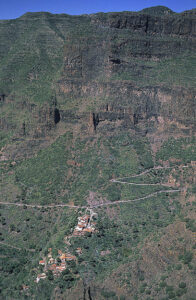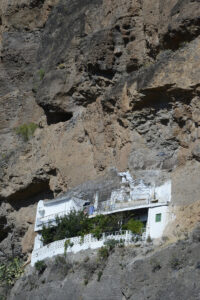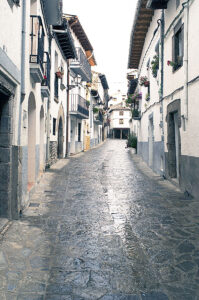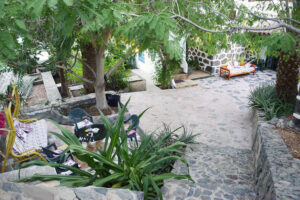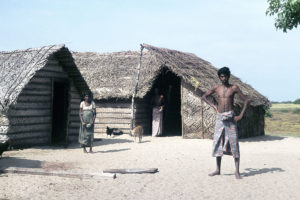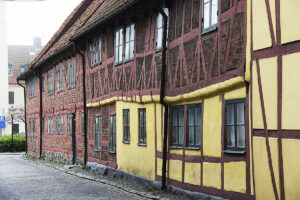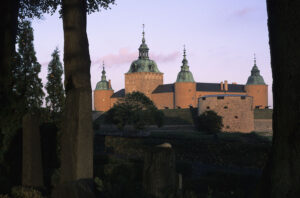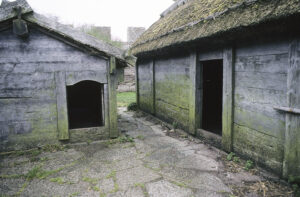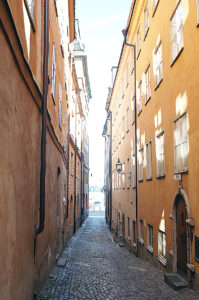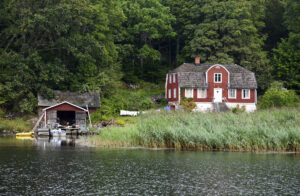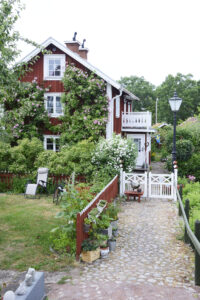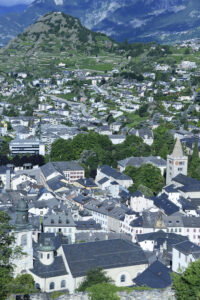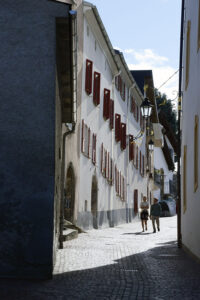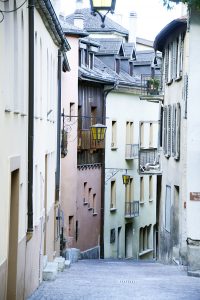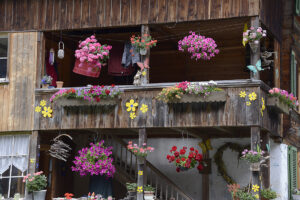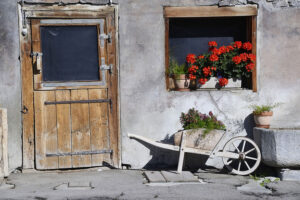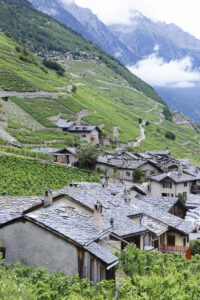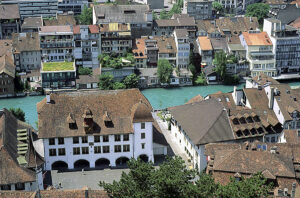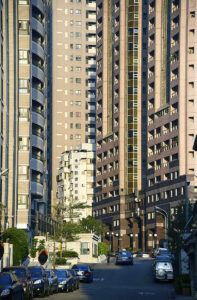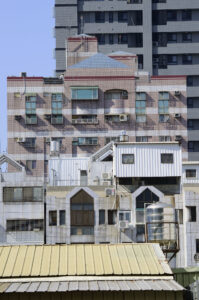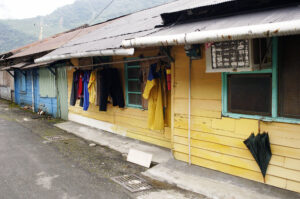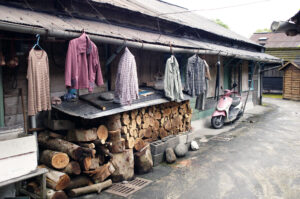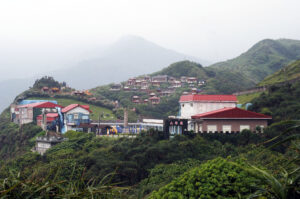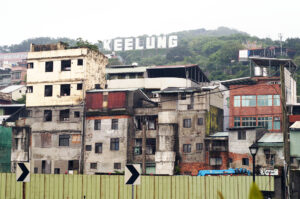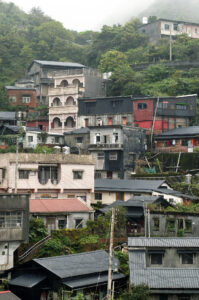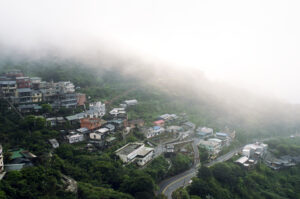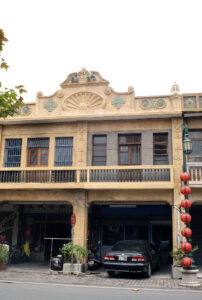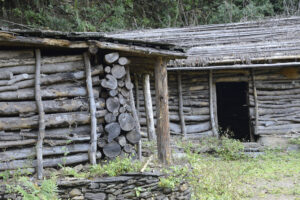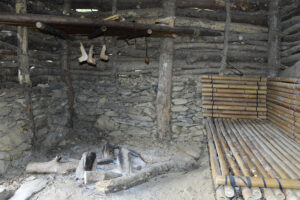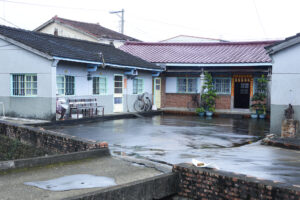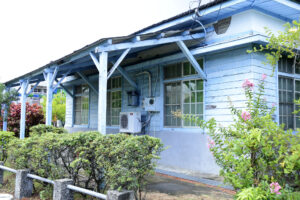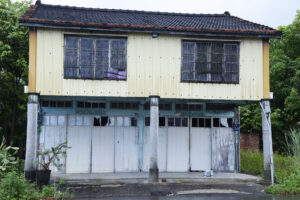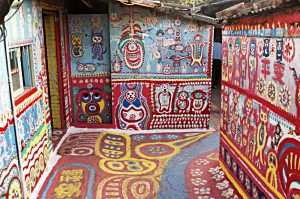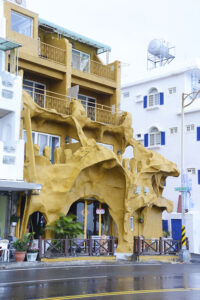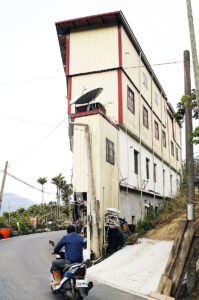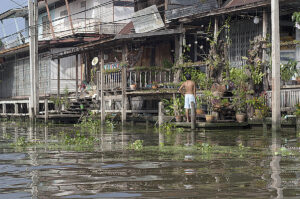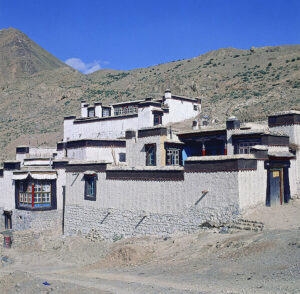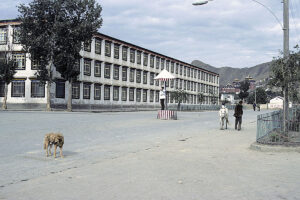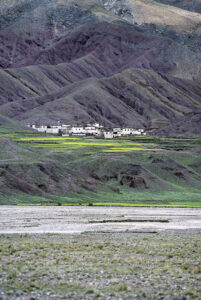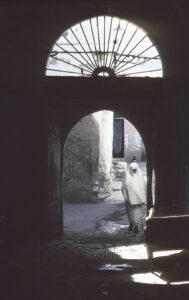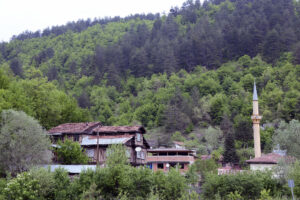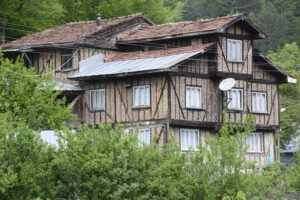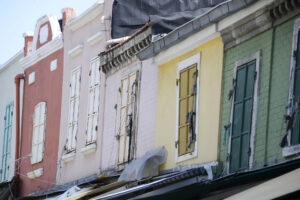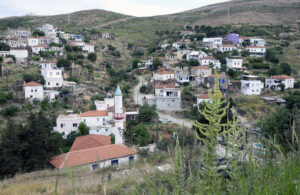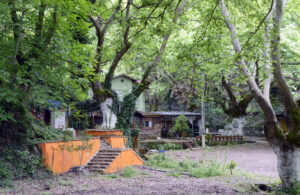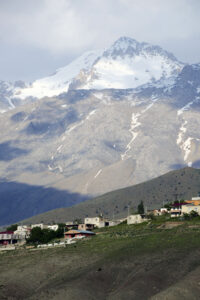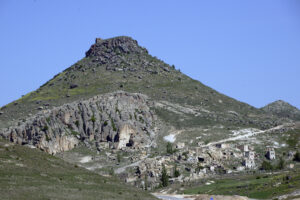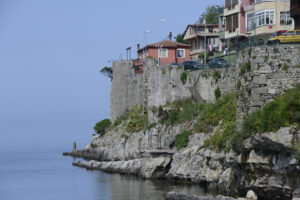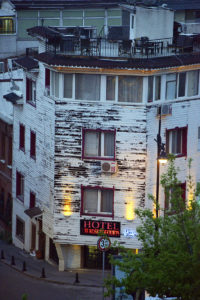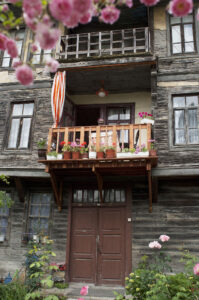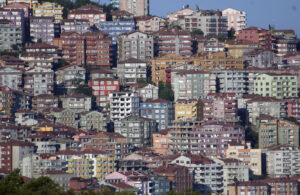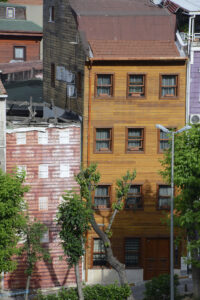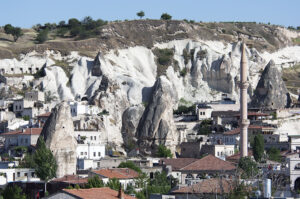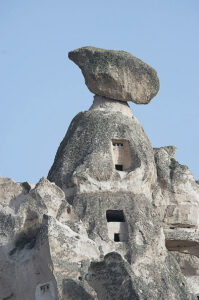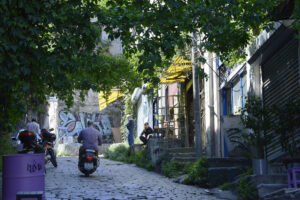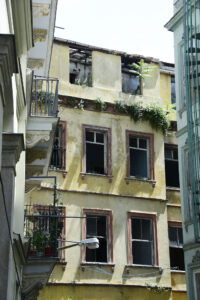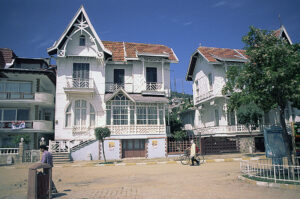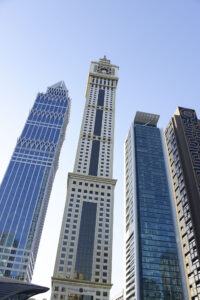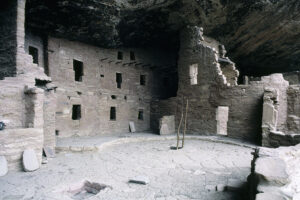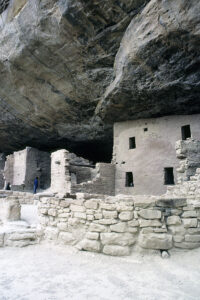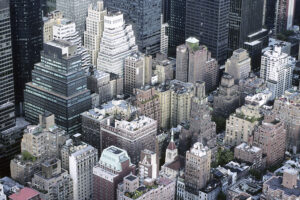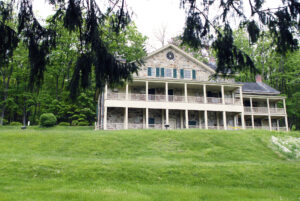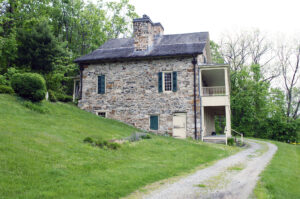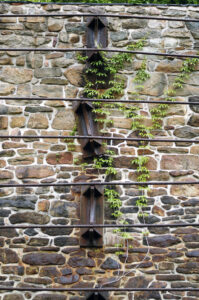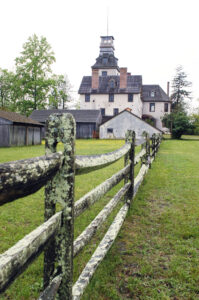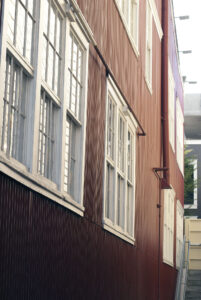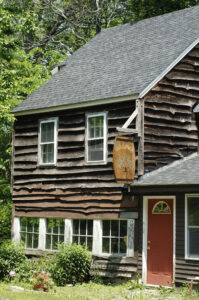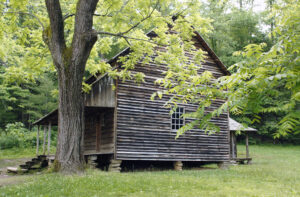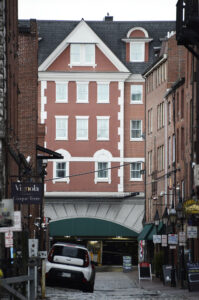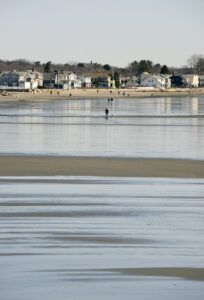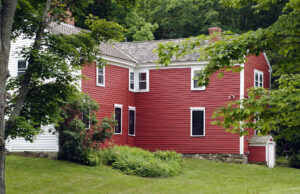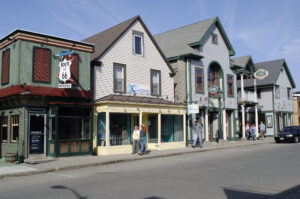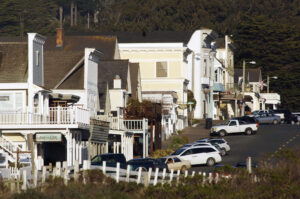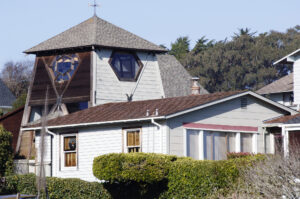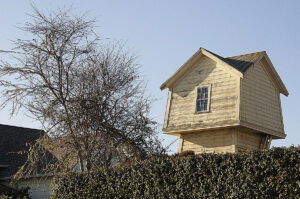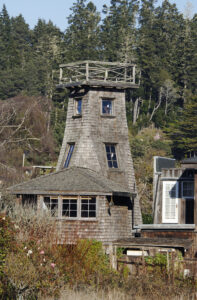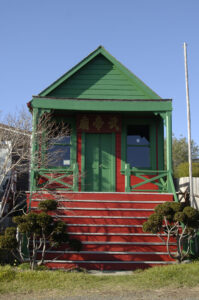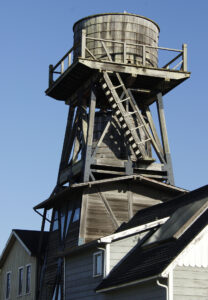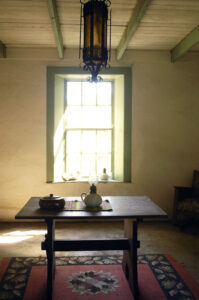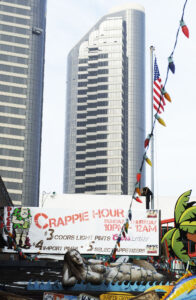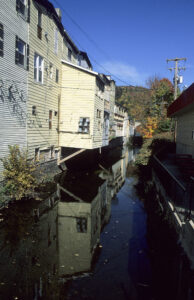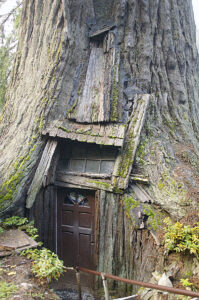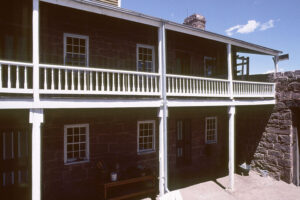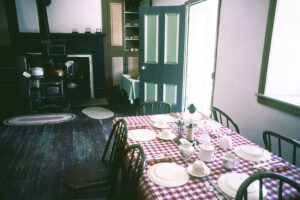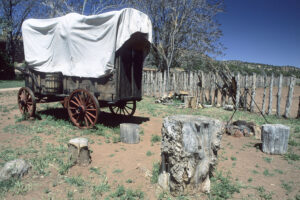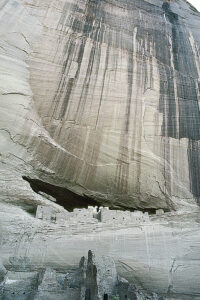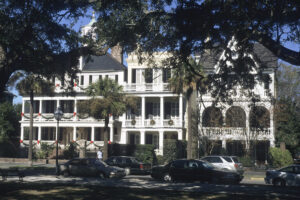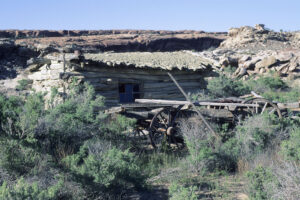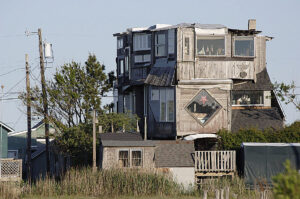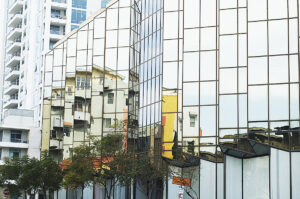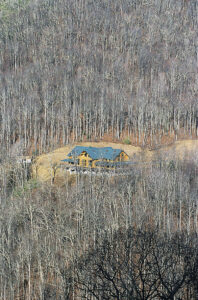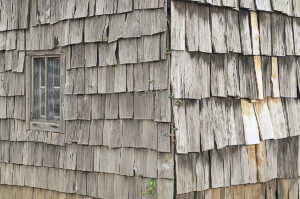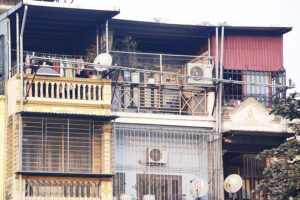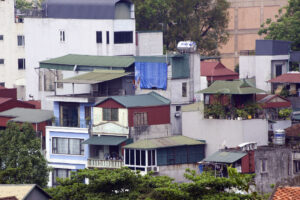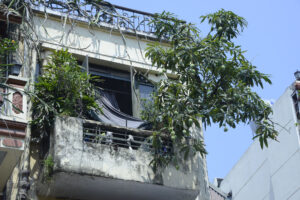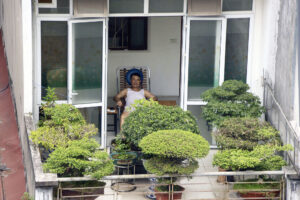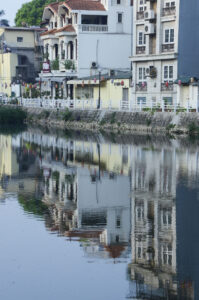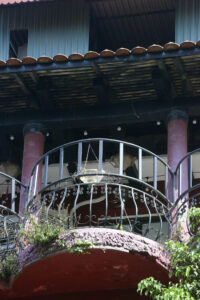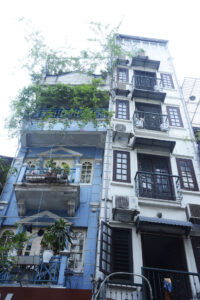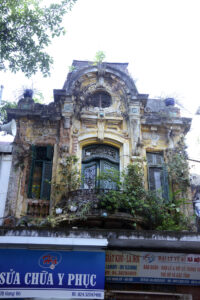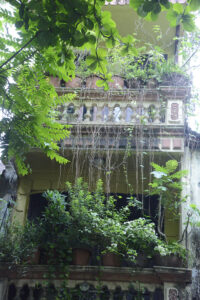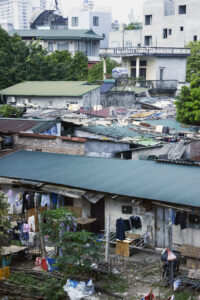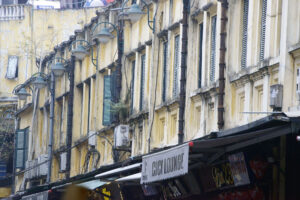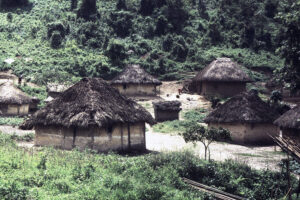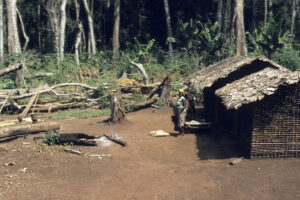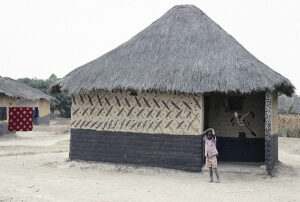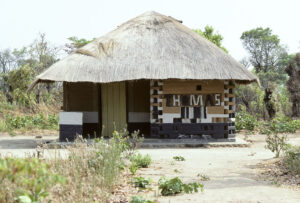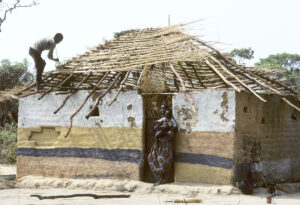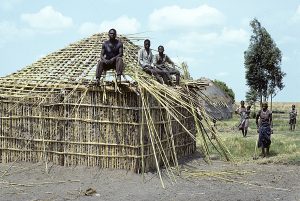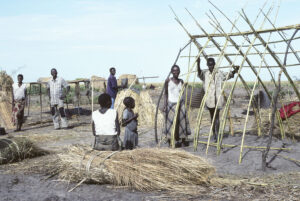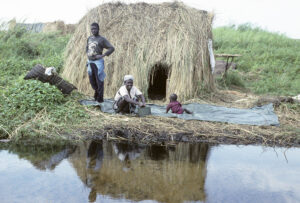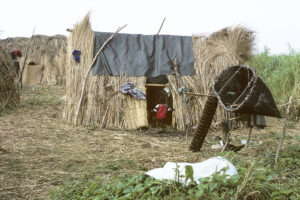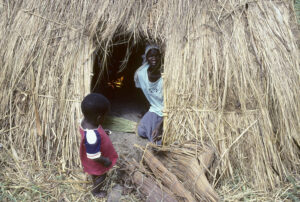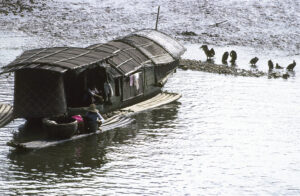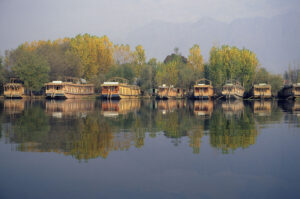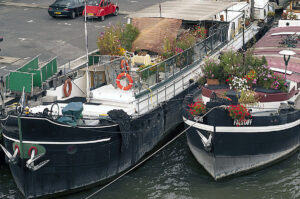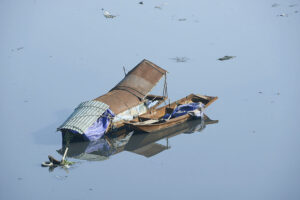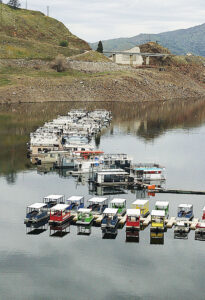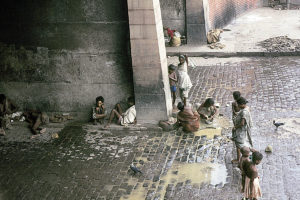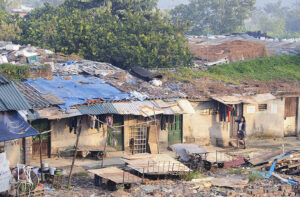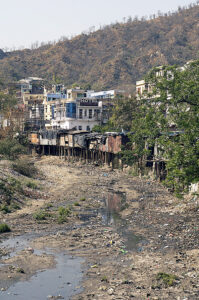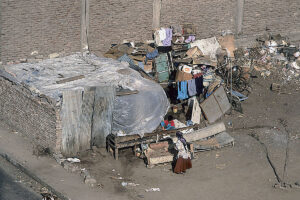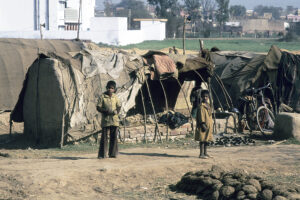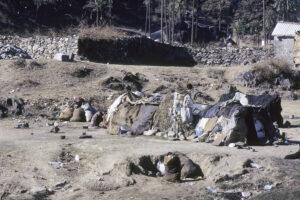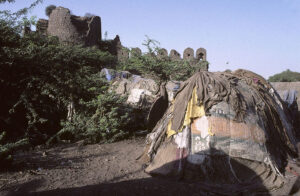A place to live
Sunset over Lusaka, the capital of Zambia. (Photo copyright © by Kaj Halberg)
Farm houses and grazing cattle, Sölktal Valley, Austria. (Photo copyright © by Kaj Halberg)
Skyscrapers, Hanoi, Vietnam. (Photo copyright © by Kaj Halberg)
House, surrounded by autumn forest, Berkshire, Massachusetts, United States. The trees with flaming foliage are red maple (Acer rubrum, wine-red) and sugar maple (Acer saccharum, orange). More than a hundred Canada geese (Branta canadensis) are swimming about in the lake. This bird is described on the page Animals – Birds: Birds in the United States and Canada. (Photo copyright © by Kaj Halberg)
Street in Valparaiso, Chile. (Photo copyright © by Kaj Halberg)
The pictures on this page are arranged alphabetically, according to country name. At the bottom of the page are separate sections on house boats and slum.
Austria
Morning light on a row of houses in the town of Golling, Salzburg. (Photo copyright © by Kaj Halberg)
Winter in the town of Annaberg im Lammertal, Salzburg. (Photo copyright © by Kaj Halberg)
Belgium
Appartments, Liège. (Photo copyright © by Kaj Halberg)
Tonle Sap is the largest lake in Southeast Asia. This lake is home to a rather large group of Vietnamese, living in so-called ‘floating villages’ – houses built on pontoons or rafts, anchored to the lake bottom. Other pictures from this area may be seen on the page Culture: Boats.
Vietnamese houses, Tonle Sap. (Photos copyright © by Kaj Halberg)
Women in a village near Garoua. (Photo copyright © by Kaj Halberg)
Canada
Street in Quebec City. (Photo copyright © by Kaj Halberg)
Valparaiso is a large city on the Chilean coast, erected on dozens of steep hills. It is home to about 300,000 inhabitants. A collection of pictures below shows the interesting architecture of this attractive city, which has caused Unesco to declare it a World Heritage Site.
(Photos copyright © by Kaj Halberg)
Decorated window panels, Valparaiso. In the upper picture, a gull is soaring in front of the building. (Photos copyright © by Kaj Halberg)
Mansion, Cartagena. (Photo copyright © by Kaj Halberg)
Street in the desert town of Huasco, northern Chile. (Photo copyright © by Kaj Halberg)
China
Morning light on a village of the Bai minority, north of Dali, Yunnan Province. – Many pictures, depicting Chinese tribal people, are presented on the page People: Chinese minorities. (Photo copyright © by Kaj Halberg)
Houses and a church, dwarfed by skyscrapers, Guiyang, Guizhou Province. (Photo copyright © by Kaj Halberg)
These houses along a river, running through the town of Yangshuo, Guangxi Zhuang Province, are built on stilts to avoid flooding of the interior during heavy downpours. (Photo copyright © by Kaj Halberg)
Traditional houses in the Old Town, Chengdu, Sichuan Province. (Photo copyright © by Kaj Halberg)
Village house and stacked firewood, east of Zhongdian, Yunnan Province. (Photo copyright © by Kaj Halberg)
Apartment complex, Kowloon, Hong Kong. Laundry is hung out on poles to dry. (Photo copyright © by Kaj Halberg)
A house and a small garden plot, constructed on the roof of a high-rise building in Guiyang, capital of the Guizhou Province. (Photo copyright © by Kaj Halberg)
The town of Lijiang, Yunnan Province, is criss-crossed by canals. (Photo copyright © by Kaj Halberg)
Early in spring 2009, Judy and I paid a visit to the Wumeng Shan Mountains, Guizhou Province. Our adventures here are related on the page Travel episodes – China 2009: Among black-necked cranes.
Village in the Wumeng Shan Mountains, covered by a thin layer of newly fallen snow. (Photo copyright © by Kaj Halberg)
Comoro Islands
Houses with grass-thatch roofs, village of Koimbani, Grande Comore. (Photo copyright © by Kaj Halberg)
Costa Rica
A modest hotel in the town Puerto Jimenez, Osa Peninsula. The sign announces: “Rooms – Forest at the Sea – hot water – fan – air condition – T.V.” (Photo copyright © by Kaj Halberg)
Farm house, near El Dos de Tilarán, Cordillera de Tilarán. (Photo copyright © by Kaj Halberg)
Houses in Tortuguero National Park, Limón. The one in the upper picture also functions as a tourist info centre. (Photos copyright © by Kaj Halberg)
Houses, Cahuita, Limón. (Photos copyright © by Kaj Halberg)
Denmark
Village of Kullerup, near Nyborg, Funen. (Photo copyright © by Kaj Halberg)
The only thing to disturb woodland serenity at this house in Store Hjøllund Plantation, central Jutland, is the faint noise from a highway. (Photo copyright © by Kaj Halberg)
This man is shaping a beam with an old-fashioned axe, an adze, during reconstruction of an Iron Age house, Lejre Museum, Zealand. (Photo copyright © by Kaj Halberg)
Reconstructed Iron Age house, Lejre. (Photo copyright © by Kaj Halberg)
Reconstructed Iron Age house, Moesgård Museum, Århus, Denmark. (Photo copyright © by Kaj Halberg)
In Scandinavia, during the Middle Ages, so-called bul houses were built of the durable oak wood. Planks were cut to fit tightly together in wooden slots, also made of oak wood. This practice meant that construction of a single house required felling of several large trees, and the supply of suitable oak trees was soon exhausted. Instead, people began building so-called half-timber houses, in which the walls consisted of a frame of oak planks, and the space between them was filled out with clay bricks, plastered with a mixture of mud and mortar.
Detail of a reconstructed Middle Age bul house, in which thick oak planks fit tightly together, Middle Age Museum of Bornholm. (Photo copyright © by Kaj Halberg)
On the island of Bornholm, many half-timber houses have been preserved, as these in the town of Gudhjem. (Photos copyright © by Kaj Halberg)
Half-timber house and pond in spring, Stevns Klint, Zealand. (Photo copyright © by Kaj Halberg)
Half-timber houses are often leaning a bit. – Nyborg, Funen. (Photo copyright © by Kaj Halberg)
Half-timber house from the 1800s, with a roof consisting of seaweed, Byerum, Læsø Island. In former days, this type of roof was typical of this island. (Photos copyright © by Kaj Halberg)
Half-timber house, near Nyborg, Funen. (Photo copyright © by Kaj Halberg)
Town of Gudhjem, Bornholm. (Photo copyright © by Kaj Halberg)
Hirsholmene is a group of 8 islets in northern Kattegat, c. 7 km north-east of Frederikshavn. The largest island is Hirsholm, where once upon a time 225 people lived, but today only one: a caretaker. The other houses in the village are summer houses.
Some pictures, depicting the rich bird life on these islands, are shown on the page Quotes on Nature.
‘The Street’, Hirsholm. (Photo copyright © by Kaj Halberg)
The town of Ribe, seen from the cathedral, Jutland. (Photo copyright © by Kaj Halberg)
Gjorslev Estate, Stevns, Zealand, was built around 1400 on the order of the Bishop of Roskilde, Peder Jensen Lodehat (died 1416). This powerful man was chancellor of Denmark, and friend and adviser of Queen Margrete I (1353-1412).
Today, Lodehat’s castle consists of a 30-metre-high tower and four buildings, erected in the shape of a cross, built of bricks and limestone from the Cliffs of Stevns. They are surrounded by a moat. In 1638 and 1843, respectively, two wings were added. (Source: gjorslev.dk/Gjorslevhistorie.htm)
Horse, grazing in front of Gjorslev Estate. Leaves of a London planetree (Platanus x acerifolia) are seen in the foreground. (Photo copyright © by Kaj Halberg)
Restored farm house, near Lake Rørbæk, Jutland. (Photo copyright © by Kaj Halberg)
Exposed houses on a sand spit, Slipshavn, Nyborg, Funen. (Photo copyright © by Kaj Halberg)
In the 1600s, a number of wars were fought between Denmark and Sweden. The Danish King, Christian V, ordered a fortress erected on two tiny islets near the island of Bornholm, in the Baltic Sea, south of Sweden. Construction took place 1684-1687. These islands, which had until then been uninhabited, were named Christiansø, in honour of the king, and Frederiksø, in honour of his successor, Frederik IV.
This picture shows the former staff quarters on Christiansø, called Gaden (‘The Street’). Today, apartments have been constructed in these buildings. (Photo copyright © by Kaj Halberg)
Egypt
Years ago, homeless people began to settle in a graveyard near the Hakim Mosque, Old Cairo. Over the years, an entire community has evolved – a town within the town of the dead. (Photos copyright © by Kaj Halberg)
Donkey carts in front of the village of Qurnet Murai, Deir-el-Madina, Luxor. (Photo copyright © by Kaj Halberg)
Estimates vary, but there may be as many as 3 or 4 million Nubians living in Egypt. When the Condominium Agreement of 1899 fixed the boundary between Egypt and Sudan, Lower Nubians found themselves under direct Egyptian rule and politically separated from their kin to the south. This arbitrary frontier divided the Nubian-speaking people more or less equally between Egypt and Sudan.
Close ties of culture, language, and family continue to unite the people north and south of the border, and until the evacuation of 1964, which accompanied the building of the Aswan High Dam, there was continual visiting back and forth between them.
Egyptian Nubia is part of the Governorate of Aswan, which also includes a populous area, whose inhabitants are not Nubian. As a result, Nubians have found themselves a minority within their native province. (Source: minorityrights.org/minorities/nubians)
Nubian village on the Sehel Island, in the Nile River, Aswan. The houses may look very traditional, but people are not out of touch with the modern way of life, as is evident from the satellite dish. (Photo copyright © by Kaj Halberg)
Estonia
Houses in Tallinn, seen from Old Tallinn. (Photo copyright © by Kaj Halberg)
Wooden houses in the town of Lihula. (Photo copyright © by Kaj Halberg)
Wooden house in the town of Suure-Jaani. (Photo copyright © by Kaj Halberg)
Ethiopia
The town of Lalibela is famous for its unique array of churches and monasteries, dating back to the 11th and 12th centuries. This interesting place is described in detail on the page Travel episodes – Ethiopia 1996: Timkat – a Christian festival.
Stone houses in Lalibela. The plants in the upper picture are agaves. (Photos copyright © by Kaj Halberg)
Village and cattle, Bahir Dar, Lake Tana. (Photo copyright © by Kaj Halberg)
Farmland and village, near Kayet. (Photo copyright © by Kaj Halberg)
Faroe Islands
The village of Tjørnuvik, Streymoy. (Photo copyright © by Kaj Halberg)
France
Village east of Millau, Cévennes Mountains. (Photo copyright © by Kaj Halberg)
Houses in the village of Bonneval-sur-Arc, Val d’Arc, south-eastern France. (Photos copyright © by Kaj Halberg)
Germany
Typical apartment blocks from the Communist Era in the city of Leipzig, which, until 1989, was situated in East Germany. (Photo copyright © by Kaj Halberg)
Farm houses and a hay tedder, near Westerhever, Eiderstedt, Schleswig-Holstein, 1975. (Photos copyright © by Kaj Halberg)
Village in the Bühler Valley, Black Forest. (Photo copyright © by Kaj Halberg)
Greece
Alley in the town of Rethymno, Crete. (Photo copyright © by Kaj Halberg)
Houses, Chania, Crete. Orange trees are seen in the foreground. (Photo copyright © by Kaj Halberg)
Greenland
Houses in Nuuk, the capital of Greenland. (Photo copyright © by Kaj Halberg)
Guatemala
Antigua, the former capital of Guatemala, is a gorgeous old Spanish colonial town, with cobbled streets, pastel-colored houses, arches across the streets, and a huge number of spectacular churches. This city is presented in detail on the page Travel episodes – Guatemala 1998: Country of the Mayans.
Many houses in Antigua are well-preserved, often painted in pastel colours. (Photos copyright © by Kaj Halberg)
A green and shady patio in front of a residential house, Antigua. (Photo copyright © by Kaj Halberg)
Iceland
Farm in the Aðaldal Valley, northern Iceland, surrounded by snow-clad mountains. (Photo copyright © by Kaj Halberg)
India
Udaipur is a gorgeous city in Rajasthan, which is described in depth on the page Travel episodes – India 1991: Attending Hindu festivals in Rajasthan.
Yellowish evening light on snow-white houses along Lake Pichola, Udaipur. (Photo copyright © by Kaj Halberg)
Woman, looking out a window, Udaipur. (Photo copyright © by Kaj Halberg)
Fishing nets, drying in front of a house in Srinagar, Kashmir Valley. (Photo copyright © by Kaj Halberg)
Village house, decorated with a painting depicting peacocks (Pavo cristatus), near Sawai Madhopur, Rajasthan. Dried cow dung is stacked in front of the house, later to be used as fuel. (Photo copyright © by Kaj Halberg)
This diesel engine in the Little Rann of Kutch, Gujarat, is pumping salty groundwater into a pan, where the water evaporates, leaving the salt behind. The tent is the home of a salt worker’s family. (Photo copyright © by Kaj Halberg)
Khond tribal village, near Rayagada, Odisha (Orissa). – Other pictures, depicting Indian tribal people, are presented on the pages People: Vanishing peoples of India, and People: Children around the world. (Photo copyright © by Kaj Halberg)
While black rain clouds are looming on the horizon, a patch of morning sunshine illuminates the town of Ooty, a hill station in the Nilgiri Mountains, Tamil Nadu. (Photo copyright © by Kaj Halberg)
Spiti (pronounced as Piti by the local Tibetan population) is a green valley in an otherwise barren landscape, situated in the north-eastern part of Himachal Pradesh. The name means ‘the land in the middle’, i.e. the land between India and Tibet. The main religion of the area is Tibetan Buddhism, or Lamaism.
Spiti River and the village of Kaza, with a flowering Rosa webbiana in the foreground. – Spiti, Himachal Pradesh, India. (Photo copyright © by Kaj Halberg)
The village of Lossar, Spiti Valley. (Photo copyright © by Kaj Halberg)
Old Town, Bikaner, Rajasthan. Blue buildings indicate residences of high caste Brahmins. (Photo copyright © by Kaj Halberg)
Ladakh is a barren land in north-western India. Geologically it constitutes a part of the Tibetan Plateau. This outlying part of the Himalaya is characterized by sharply rising sedimentary rocks, which have been eroded into any imaginable shape.
Formerly, Ladakh was a province in the state Jammu and Kashmir. However, there was a huge resistance in the population against this arrangement, as the Ladakhis, justly, felt that they were treated unfairly by the Muslim government in Srinagar. The people and language of Ladakh are of Tibetan origin, and the dominating religion is Tibetan Buddhism, or Lamaism.
The Indian government has proclaimed that from October 31, 2019, Ladakh constitutes a Union Territory, ruled by the central government in Delhi.
In former days, among the Ladakhi population, the will to share was widespread. There was a common responsibility to keep the water courses clean, as their water was utilized in the households. At harvest time, everybody participated in helping each other. These sympathetic features largely vanished, when the area was opened to tourism in 1972. Today, a common consumer capitalism is prevailing, at least in the cities.
Eroded mountains in morning light around the village of Hinju, Markha Valley, Ladakh. (Photo copyright © by Kaj Halberg)
The village of Ulley, Ladakh, surrounded by barren, eroded mountains. (Photo copyright © by Kaj Halberg)
This gompa (Tibetan Buddhist monastery) in the village of Lamayuru, Ladakh, has a dramatic setting, built atop eroded crags, whereas the village houses have been built beneath the rocks. Gompas are described in depth on the page Religion: Buddhism. (Photo copyright © by Kaj Halberg)
The town of Pushkar, Rajasthan, is situated around a lake, which is sacred to Hindus. These pictures were taken from the Saraswati Temple, located on a nearby hill. (Photo copyright © by Kaj Halberg)
The vast Thar Desert stretches across the state of Rajasthan and further west into Pakistan. This desert is surprisingly densely populated. Scattered across the bleak landscape lie numerous towns and villages, inhabited by various peoples, belonging to various religions, including Jains, Bishnois, Muslims, and Hindu Rajputs.
During the era of the great trading caravans, a side branch of the Old Silk Road led through the city of Jaisalmer, near the Pakistani border. Travelling along this route, numerous camel caravans brought goods to and from India, trading with faraway China, Persia, Turkey, and Europe. As wealth accumulated in Jaisalmer, rich traders built extravagant and ornate sandstone mansions, called havelis, their walls and balconies decorated with beautiful and detailed carvings.
Jaisalmer and the Thar Desert is dealt with in detail on the page Travel episodes – India 2003: Camel safari in the Thar Desert.
Gorgeous havelis in Jaisalmer. (Photos copyright © by Kaj Halberg)
As a stark contrast to the mansions above, this picture shows a narrow lane in Jaisalmer. (Photo copyright © by Kaj Halberg)
Wattle-and-daube houses in the village of Khorma, Thar Desert. (Photos copyright © by Kaj Halberg)
Late afternoon light on houses in the village of Khudi, Thar Desert. (Photo copyright © by Kaj Halberg)
House in the village of Mari, Thar Desert. (Photo copyright © by Kaj Halberg)
House in the village of Bhopa, Thar Desert. (Photo copyright © by Kaj Halberg)
Village near Sam, Thar Desert. (Photo copyright © by Kaj Halberg)
The city of Jodhpur, Rajasthan, was founded in 1459 by Rajput Prince Rao Jodha. The Old Town is aptly called The Blue City, as most of its houses are painted a light blue. Originally, these blue houses were inhabited by Brahmins, and their colour indicated that here you could ask advice about disease as well as religious issues. Furthermore, the blue paint contains copper oxides, which keep termites at bay.
Blue houses, Jodhpur. (Photo copyright © by Kaj Halberg)
Houses in evening light, Jodhpur. In the background the huge rock-top fort Mehrangarh. (Photo copyright © by Kaj Halberg)
Village at the foot of a rocky hill near Mount Abu, Rajasthan. (Photo copyright © by Kaj Halberg)
Habitation in Old Delhi, seen from the Jama Mashid (‘Friday Mosque’). (Photo copyright © by Kaj Halberg)
Houses along the shore of Dal Lake, Kashmir. (Photo copyright © by Kaj Halberg)
‘Synagogue Lane’, a street leading down to the Jewish Pardesi Synagogue, Matancherry, Kochi, Kerala. (Photo copyright © by Kaj Halberg)
Indonesia
Children, peeping out from the door opening in their home, made of split bamboo stems, in a village near Kintamani, Bali. The shy girl only shows an eye! (Photo copyright © by Kaj Halberg)
The Batak are a group of closely related Austronesian peoples, including the Karo, Pakpak, Simalungun, Toba, Angkola, and Mandailing, who live in a large area of northern Sumatra, Indonesia. My acquaintance with these people stems from a visit to Lake Toba in 1975.
Pictures, depicting Batak people, are shown on several pages on this website, including People: Children around the world, Culture: Musicians, and Portraits.
Beautifully decorated Batak tribal houses in the village of Porsea, Sumatra, one with an old-type straw roof, another with a corrugated tin roof. (Photos copyright © by Kaj Halberg)
Iran
In 1973, together with my late friend Arne Koch Christoffersen, I stayed for several weeks in Luristan, south-western Iran. Our at times rather bizarre adventures in this area are described on the page Travel episodes – Iran 1973: In the mountains of Luristan.
Farm house in Luristan. (Photo copyright © by Kaj Halberg)
In 1973, when this picture was taken, the houses in this village in the Alborz Mountains were constructed along a rock wall and partly built into caves. Our visit to these mountains is related on the page Travel episodes – Iran 1973: Car breakdown at the Caspian Sea. (Photo copyright © by Kaj Halberg)
Iraq
For thousands of years, a huge marsh area in southern Iraq, between the Euphrates and Tigris Rivers, was the home of the Madan tribe, whose way of life was completely adapted to the wet habitat. They moved about in canoes, built their reed houses on islets, and made a living by hunting and fishing, growing rice, and raising water buffaloes.
The regime of Saddam Hussein Abd al-Majid al-Tikriti (1979-2003) put an end to their way of life by draining the marshes, as a retaliation for the Madan siding with the Americans during the First Gulf War (1990-1991).
This interesting wetland is presented in detail on the pages Travel episodes – Iraq 1973: The hospitable mudir, and Iraq 1973: Dust storm and sheep’s head.
These pictures are from 1973, prior to the destruction of the marshes. At that time, there were almost no roads in the marshes, and people got around in long, slender canoes, called meshof. In both pictures, flat cakes of cow dung are laid out to dry in the sun, later to be used as fuel. The woman is baking flat loaves of bread, called hrobes, in a clay oven. (Photos copyright © by Kaj Halberg)
In the 1970s, some bedouins in the Syrian Desert were still living in black tents. In this picture from 1973, a family has erected their tent at the outskirts of the great marshland. (Photo copyright © by Kaj Halberg)
Ireland
Chimneys on densely packed houses, Dublin. (Photo copyright © by Kaj Halberg)
For hundreds of years, the Dingle Peninsula, south-western Ireland, was a remote area, where the Gaelic-speaking population adhered to their language and culture. Today, this peninsula is a very popular tourist destination.
A patch of sunshine partly illuminates a valley with farm houses and fields, enclosed by stone walls, Dingle Peninsula. (Photo copyright © by Kaj Halberg)
Street in Dingle, the main town of the peninsula. (Photo copyright © by Kaj Halberg)
Italy
Ragusa is a marvellous city, erected on a hill that rises 300 m between two deep valleys. It has about 70,000 inhabitants. Together with seven other cities in this area, it constitutes part of a UNESCO World Heritage Site.
As far back as the 2nd Millennium B.C., people of the Sicel culture were living here. When a larger settlement came into existence, it came into the hands of numerous peoples throughout history. Greeks, Carthaginians, Romans, Byzantines, Arabs, and Normans ruled, before the city became part of the Kingdom of Sicily, which arose in the 12th Century.
Ragusa, Sicily. (Photos copyright © by Kaj Halberg)
Extention upon extention of a house, Castellamare del Golfo, Sicily. (Photo copyright © by Kaj Halberg)
Jordan
The city of Salt, as of 1977. (Photo copyright © by Kaj Halberg)
The Nabataeans were an Arab people, in Arabic called al-ʾAnbat, who, around the 1st Century A.D., lived in the northern part of the Arabian Peninsula and in present-day Jordan and Israel. Their assumed capital was Raqmu, today called Petra, which had an estimated population of 20,000.
In 1977, when this picture was taken, very few tourists visited the gorgeous ruins of Petra. In those days, some of the caves of the area were still inhabited. (Photo copyright © by Kaj Halberg)
Kosovo
Farm house in the Mokra Mountains. (Photo copyright © by Kaj Halberg)
Malawi
Lake Malawi is the third-largest lake in Africa, 575 km long and up to 85 km wide, covering an area of c. 23,000 km2. This great lake is described in depth on the page Travel episodes – Malawi 1997: A three-day ferry cruise on Lake Malawi.
Village on the western shore of Lake Malawi, near Monkey Bay. (Photo copyright © by Kaj Halberg)
Malaysia
The indigenous population of Borneo constitutes various Malayan tribes, including Iban, Punan, Kayan, Kelabit, and Penan, known by the common name Dayaks. Usually, a Dayak village consists of only one house, called a longhouse, which is in fact an entire community under one roof.
You may read more about Dayaks and longhouses on the page Travel episodes – Borneo 1975: Canoe trip with Punan tribals.
Longhouse near the town of Kapit, Sarawak. (Photos copyright © by Kaj Halberg)
The border town of Tijuana, seen through haze from the American side. (Photos copyright © by Kaj Halberg)
Montenegro
Village and boats, Lake Skadarsko. (Photo copyright © by Kaj Halberg)
Farm houses, near Kolasin. (Photo copyright © by Kaj Halberg)
Morocco
The city of Meknès, northern Morocco, originally called Amknas in the Berber language, was founded in the 11th Century by the Almoravids. It became capital of Morocco during the reign of Sultan Moulay Ismaïl (1672-1727), who turned it into an impressive city, with a harmonious blending of the Islamic and European Maghreb styles. (Source: whc.unesco.org/en/list/793)
Our troubles in this city are described on the page Travel episodes – Africa 1980: Arduous journey across Africa.
Originally, a medina, in Arabic al-madinah al-qadimah (‘old city’), was a distinct city section in North African cities, and in Malta. A typical medina is surrounded by a wall and has many narrow, maze-like streets, like this one in the medina of Meknès. (Photo copyright © by Kaj Halberg)
Myanmar
This longboat transports passengers and goods down the main canal in the town of Nyaung Shwe, near Lake Inle. The houses in the background are built on stilts. – Other pictures from this area may be seen on the page Culture: Boats. (Photo copyright © by Kaj Halberg)
Namibia
Hans Goerke was born in Germany in 1874 and came to Deutsche Südwestafrika (today Namibia) in 1904 with the German colonial forces. Following the discovery of diamonds at Kolmannskuppe, he resigned from the army and began digging for diamonds. He made a fortune and built a huge mansion in Lüderitz.
Houses, Lüderitz. Hans Goerke’s house is the pale blue one. (Photos copyright © by Kaj Halberg)
Nepal
Early morning light partly illuminates a huge house, with beautiful wooden balconies, in the town of Ilam, eastern Nepal. (Photo copyright © by Kaj Halberg)
In later years, Kathmandu, the capital of Nepal, has grown out of proportions. Today, it covers the entire valley, with an estimated population of 5 million. (Photo copyright © by Kaj Halberg)
Farm and grazing water buffaloes, Dinchire Pass, eastern Nepal. Rhododendron arboreum is blooming in the forest. (Photo copyright © by Kaj Halberg)
The hamlet of Sherpagaon, Langtang Valley, central Nepal. (Photo copyright © by Kaj Halberg)
Bandipur is a town in central Nepal, in which many traditional houses have been preserved. (Photo copyright © by Kaj Halberg)
Villages in the upper valleys of northern Nepal experience a very harsh climate, with intensely cold winters, and cool summers with fierce sunshine. The roofs are flat, indicating that rainfall in these areas is sparse, and a typical sight in these villages are firewood and brushwood, stacked on roofs or walls.
Many of these villages are dominated by Buddhist Tibetan peoples, and prayer flags are often attached to poles on the house roofs, fluttering in the wind. These brightly coloured pieces of cloth, on which mantras are printed, are always placed in this order: blue, white, red, green, and yellow. When they flutter in the wind, the mantras on them are dispersed into space, for the benefit of humankind.
Tibetan Buddhism is dealt with in detail on the page Religion: Buddhism.
In the pictures below, a thin layer of newly fallen snow partly covers the houses in the village of Ghyaru, situated at an altitude of 3,650 m, Upper Marsyangdi Valley, Annapurna. In the lower picture, yak skulls have been placed on a stone wall, and juniper branches are drying, later to be used as fuel.
The yak is described in depth on the page Animals: Animals as servants of Man.
(Photos copyright © by Kaj Halberg)
In the village of Braga, likewise in the Upper Marsyangdi Valley, houses are built very close to one another up a slope, the roof of one house acting as a terrace of the house above. (Photo copyright © by Kaj Halberg)
The village of Kagbeni is situated in the dry Upper Kali Gandaki Valley, in the district of Mustang. (Photo copyright © by Kaj Halberg)
Farm house near the village of Dana, Kali Gandaki Valley, Annapurna. Firewood has been stacked in the shed to the right. (Photo copyright © by Kaj Halberg)
Many farm houses in Nepal are ochre-coloured, built in two storeys, like these in the Kathmandu Valley (upper two), and in the village of Ghare, Annapurna. (Photos copyright © by Kaj Halberg)
Narrow alley in the city of Bhaktapur, Kathmandu Valley. This city is mainly inhabited by Newars, a people of mixed Indo-European and Mongolian origin. (Photo copyright © by Kaj Halberg)
Thulo Shyabru is a village, situated on a ridge in Langtang National Park. A few houses in this village are constructed of wood, with beautifully carved window frames, but this millennia-old craft is quickly disappearing, giving way to houses built of bricks or concrete, with pre-fabricated windows.
Beautifully carved window frames, Thulo Shyabru. (Photo copyright © by Kaj Halberg)
The village of Namche Bazaar has been established around a natural well in a bowl-shaped depression on a mountain slope in the Khumbu area, eastern Nepal. This village is mainly known for a huge market, taking place here every Saturday.
Namche Bazaar, seen from a nearby hilltop. (Photo copyright © by Kaj Halberg)
Houses in the village of Chovar, Kathmandu Valley. (Photo copyright © by Kaj Halberg)
Sections of the main street, leading through the village of Larjung, Kali Gandaki Valley, are covered, giving the impression of walking through tunnels. (Photo copyright © by Kaj Halberg)
Many of the houses in the town of Taplejung, eastern Nepal, are painted blue. (Photo copyright © by Kaj Halberg)
New Zealand
In all probability, the Grand Hotel, situated in the town of Helensville, once lived up to its name, but maybe it is not so grand anymore? (Photo copyright © by Kaj Halberg)
Norway
Midnight sun, illuminating houses in the village of Ekkerøy, Varanger Peninsula. (Photo copyright © by Kaj Halberg)
Pakistan
Workers’ quarters in front of a factory, producing fertilizers, Multan, Sind. Note that a bed has been taken out and place in the morning sun. (Photo copyright © by Kaj Halberg)
The Ifugao is one out of a dozen Malayan tribes, who inhabit the northern parts of the island of Luzon. At least 2,000 years ago, this people constructed fantastic terraced fields on the mountain slopes, irrigated through an advanced system of canals. On these terraces, they grow their main staple, rice, supplied with sweet potatoes, taro, and various vegetables. They also raise chickens and black pigs, and the men hunt wild animals in the jungle.
My adventures among this people are related on the page Travel episodes – Philippines 1984: Shamanism among Ifugao tribals.
Houses in the village of Bocos, Banawe. (Photo copyright © by Kaj Halberg)
Wooden houses with corrugated iron roofs, Bontoc, Luzon. (Photo copyright © by Kaj Halberg)
Portugal
Lane with bougainvillea, Funchal, Madeira. (Photo copyright © by Kaj Halberg)
Puerto Rico
Street in San Juan, the capital of Puerto Rico. (Photos copyright © by Kaj Halberg)
Apartment building and house, Domodedovo, near Moscow. (Photos copyright © by Kaj Halberg)
During the heydays of the Soviet Union, the city of Anadyr, Chukotka Province, Siberia, was of huge importance due to the presence of a gigantic missile launch, in which several missiles, armed with nuclear weapons, were aimed at various targets in the U.S. Following the collapse of the Soviet Union, the whole business was covered with soil, and the importance of Anadyr vanished.
Today, this area bears the marks of decay and indifference, in equal measures. Rubble, wires, iron pipes, oil drums, scrapped trucks, workmen’s huts, and a lot of other rubbish is ubiquitous, and nobody cares to clean up the mess. During the Soviet Era, you just did what you were told, which does not exactly encourage personal initiative. Today, when you are not told to do anything, it seems that nobody wants to take the trouble to clear the mess, and thus beautify the area.
Our adventures in Chukotka are described on the page Travel episodes – Siberia 2011: Caterpillar trip in Chukotka.
Apartment buildings in Anadyr Airport City, Chukotka. The ones in front are abandoned, whereas the gaily painted ones in the background are still inhabited. (Photo copyright © by Kaj Halberg)
Scotland
Farm house, Isle of Muck, Inner Hebrides. (Photo copyright © by Kaj Halberg)
Spain
Village of El Toscón, Gran Canaria. (Photo copyright © by Kaj Halberg)
Pre-Spanish caves near Vega de Acusa, Gran Canaria. Originally, they were inhabited by the indigenous people of the islands, the Guanches, a Berber people who migrated to the islands from Morocco. Later, the caves were used by Spanish herders, who put doors in some of the openings. (Photo copyright © by Kaj Halberg)
The town of Hecho, Hecho Valley, Pyrenees. The flowers are scented geraniums (Pelargonium hortonum). (Photo copyright © by Kaj Halberg)
Village of El Carrizal, Gran Canaria. (Photo copyright © by Kaj Halberg)
Typical white-washed houses in the town of Casares, Andalusia. (Photos copyright © by Kaj Halberg)
As rain clouds move away, late afternoon sun illuminates the village of Binies, Aragon. (Photo copyright © by Kaj Halberg)
Lane in Cordoba, Andalusia. (Photo copyright © by Kaj Halberg)
The town of San Sebastián de Agüimes, Barranco de Guayadeque, Gran Canaria. Construction of the neo-classical church was initiated in the late 1700s, but it was not completed until the 1940s. (Photo copyright © by Kaj Halberg)
Village of Mogán, Gran Canaria. The birds are collared doves (Streptopelia decaocto). (Photo copyright © by Kaj Halberg)
Before construction of this serpentine road, leading down to Masca, Tenerife, Canary Islands, this village indeed had a very isolated location. (Photo copyright © by Kaj Halberg)
House, built into a rock wall, near Vega de Acusa, Gran Canaria. (Photo copyright © by Kaj Halberg)
The fortified town of Berdun, Aragon, was established on a hilltop with a wide view. The lower picture shows a street in this town, shortly after a rain shower. (Photos copyright © by Kaj Halberg)
Lodge garden in Mogán, Gran Canaria. (Photo copyright © by Kaj Halberg)
The small island Karativu, off the west coast of Sri Lanka, is only inhabited during the fishing season, and most of the fishermen leave their wives and children on the mainland. The village here consists of about a hundred huts, constructed of branches, covered with mats made from palm leaves. Some are completely open, others are equipped with palm-leaf walls.
Our adventures on Karativu, and in the neighbouring Wilpattu National Park, are related in detail on the page Travel episodes – Sri Lanka 1974: An illegal walk through Wilpattu.
Fishermen’s huts, Karativu. (Photo copyright © by Kaj Halberg)
Sweden
Half-timber houses in the old part of the city of Ystad, Skåne. (Photo copyright © by Kaj Halberg)
Kalmar Castle, eastern Sweden, in evening light. Originally, a fortified tower was erected here in the late 1100s. Later, the fortification was enlarged several times, and the present castle dates from the 1500s. (Photo copyright © by Kaj Halberg)
Reconstructed Iron Age houses from c. 500 A.D., Eketorp, Öland. (Photo copyright © by Kaj Halberg)
Alleys, Gamla Stan (‘Old City’), Stockholm. (Photos copyright © by Kaj Halberg)
House, Järnaviken, Blekinge. (Photo copyright © by Kaj Halberg)
House and garden, Pataholm, south of Oscarshamn, Småland. (Photo copyright © by Kaj Halberg)
Switzerland
The city of Sion, Valais, seen from the castle Chateau Valère. (Photo copyright © by Kaj Halberg)
Apartments along narrow lanes in Sion. (Photo copyright © by Kaj Halberg)
Red scented geraniums (Pelargonium hortonum) are very popular house plants in Switzerland. Two examples are shown below.
Village of Stechelberg, Lauterbrunnen Valley, Berner Oberland. (Photo copyright © by Kaj Halberg)
Village of Furtigen, Karner Valley, Berner Oberland. (Photo copyright © by Kaj Halberg)
Vinyards near the village of Plan Cerisier, Rhone Valley. (Photo copyright © by Kaj Halberg)
The city of Thun was established along the Aare River, Berner Oberland. This picture was taken from the city castle, Schloss Thun. (Photo copyright © by Kaj Halberg)
Taiwan
Taichung is a huge city in western Taiwan, home to about 2 million people. Many parts of this city are marked by high-rise buildings. In the upper picture, the buildings are dimmed by air pollution. (Photos copyright © by Kaj Halberg)
Wooden houses with drying laundry and stacked firewood, Morisaka, Lintian Shan, eastern Taiwan. (Photos copyright © by Kaj Halberg)
Houses near the town of Bitou, north-eastern Taiwan, with a graveyard in the background. (Photo copyright © by Kaj Halberg)
Dilapidated houses, Keelung Harbour. (Photo copyright © by Kaj Halberg)
Hill town of Jinguashi, northern Taiwan. (Photo copyright © by Kaj Halberg)
Evening clouds at the hill town of Jiufen, northern Taiwan. (Photo copyright © by Kaj Halberg)
Traditional house, Xiluo. (Photo copyright © by Kaj Halberg)
Reconstructed tribal house, near Wushe, central Taiwan. Jaws of pigs are hanging on the wall. In former days, tribals of Taiwan eagerly hunted wildboar (Sus scrofa). (Photos copyright © by Kaj Halberg)
Houses in traditional styles, Chingliao, south-western Taiwan. (Photos copyright © by Kaj Halberg)
Abandoned house, Chingliao. (Photo copyright © by Kaj Halberg)
In a suburban area of Taichung, a retired soldier has adorned an entire neighbourhood – walls, streets, doors – with colourful paintings. For this reason, the area has been dubbed Tsai Hung Tsun (‘Rainbow Village’). A number of pictures, depicting these paintings, may be seen on the page Culture: Folk art of Taiwan.
(Photo copyright © by Kaj Halberg)
This kitschy hotel is situated in Kenting, a popular holiday town in southern Taiwan. (Photo copyright © by Kaj Halberg)
A peculiar wedge-shaped house, built where two streets join at a sharp angle in the town of Rueilli. (Photo copyright © by Kaj Halberg)
Thailand
Houses, built on poles along a lake shore, Damnoensaduak. (Photo copyright © by Kaj Halberg)
Tibet
In 1987, I stayed a couple of weeks in the town of Shigatse. At that time, Chinese authorities had already begun levelling large areas of the town to create a ‘modern’ (i.e. communist concrete style) town. In 2004, I visited Shigatse again, and very little remained of the old quarters.
My adventures here, and elsewhere in Tibet, are related on the page Travel episodes – Tibet 1987: Tibetan summer.
Beautiful old-style houses, Shigatse, 1987. (Photo copyright © by Kaj Halberg)
Modern Chinese house complex, Shigatse, 1987. In those days, traffic in this town was almost non-existing, so this police officer, directing traffic in a brand-new street crossing, is not overwhelmed by his work. (Photo copyright © by Kaj Halberg)
Village and mustard fields, east of Tso La. (Photo copyright © by Kaj Halberg)
Tunisia
Originally, a medina, in Arabic al-madinah al-qadimah (‘old city’), was a distinct city section in North African cities, and in Malta. A typical medina is surrounded by a wall and has many narrow, maze-like streets. This picture shows a gateway in the medina of Sousse. (Photo copyright © by Kaj Halberg)
Turkey
Half-timber house and minaret in the village of Çatören, Ilgaz Dağlari, between Çankiri and Kastamonu. (Photos copyright © by Kaj Halberg)
The town of Bornova, western Turkey (as of 1973). (Photo copyright © by Kaj Halberg)
Houses, Izmir. (Photos copyright © by Kaj Halberg)
Village on the Karaburun Peninsula, near Izmir. (Photo copyright © by Kaj Halberg)
House in a forest, Boz Dağlari, east of Manisa. (Photo copyright © by Kaj Halberg)
Village at the foot of Ala Dağları. (Photo copyright © by Kaj Halberg)
Abandoned village, Sivrihisar, near Güzelyurt, east of Aksaray. (Photos copyright © by Kaj Halberg)
View of the city of Amasra, Black Sea. (Photo copyright © by Kaj Halberg)
Houses above the old city wall, Amasra. (Photo copyright © by Kaj Halberg)
Early morning light on the façade of a dilapidated hotel, Sultanahmet, Istanbul. (Photo copyright © by Kaj Halberg)
Wooden house, Bartin, Black Sea coast. (Photo copyright © by Kaj Halberg)
Colourful apartment complexes in the town of Zonguldak, northern Turkey. (Photo copyright © by Kaj Halberg)
Houses, Istanbul. (Photo copyright © by Kaj Halberg)
Göreme, central Turkey, is an area with numerous earth pyramids, eroded out of a comparatively soft layer of tuff rocks. These structures are formed, where larger rocks protect the underlaying soil from being eroded by rain, over the years forming majestic pillars, which often rise steeply out of the surrounding soil.
In Göreme, caves have been carved into many of these earth pyramids, and people still live in some of them today. (Photos copyright © by Kaj Halberg)
Street and houses, near the Galata Tower, Golden Horn, Istanbul. (Photos copyright © by Kaj Halberg)
Zeytinbağı, near Mudanya, Marmara Sea. (Photo copyright © by Kaj Halberg)
Kızıl Adalar (‘Red Islands’), often called ‘Prince Islands’ in English, are a group of nine islands in the Marmara Sea, near Istanbul. This picture shows mansions on the island of Kınalı Ada. (Photo copyright © by Kaj Halberg)
United Arab Emirates
Various, more or less bizarre skyscrapers in Dubai. In the bottom picture, the top of a skyscraper is under construction, formed as a ship. (Photos copyright © by Kaj Halberg)
United States
Spruce Tree House Pueblo is an abandoned rock ledge dwelling in Mesa Verde National Park, Colorado, constructed by an Anazasi people in the 1200s, finally growing to about 114 rooms with 8 kivas, ceremonial chambers which were chiseled down into the rock floor. The site was abandoned for unknown reasons about 1300.
Spruce Tree House Pueblo. (Photos copyright © by Kaj Halberg)
As the world population has soared, people must live close together. – Manhattan, New York City, seen from Empire State Building. (Photo copyright © by Kaj Halberg)
Shippen Manor, near the town of Oxford, New Jersey, was built around 1754 on an estate, owned by the brothers William Shippen Sr. and Joseph Shippen Jr. It is said that during the American Revolution several leading revolutionaries held meetings here.
The great-niece of William Shippen Sr. was Margaret ‘Peggy’ Shippen, who, as it turned out, was a spy for the British. She married Benedict Arnold, a prominent general in the revolutionary army. She was one of the causes that he changed from being a revolutionary to being a traitor, loyal to the British Crown. (This issue is described in depth elsewhere on this website, see Novel: Rose of the Revolution.)
Shippen Manor, Oxford, New Jersey. (Photos copyright © by Kaj Halberg)
Ruin of the nearby Oxford Furnace. It is said that part of the production here was cannon balls for the revolutionaries. (Photo copyright © by Kaj Halberg)
Batsto Village, deserted and now a museum, Pine Barrens, New Jersey. (Photo copyright © by Kaj Halberg)
House in Cannery Row, Monterey, California. This street was made famous by American author John Steinbeck (1902-1968) in his 1945 novel Cannery Row. (Photo copyright © by Kaj Halberg)
Old-fashioned wooden house, Meadow Brook Conservation Area, Haverhill, Massachusetts. (Photo copyright © by Kaj Halberg)
In the plot around this house in Oyster Bay, Long Island, all large trees were felled, which caused soil erosion. It was attempted to be blocked by erecting concrete walls, which, however, were inadequate, as they have cracked in several places. (Photo copyright © by Kaj Halberg)
Tipton Place, an abandoned farm, now a museum, Cades Cove, Great Smoky Mountains National Park, Tennessee. (Photo copyright © by Kaj Halberg)
Old Portland, Maine. (Photo copyright © by Kaj Halberg)
Low tide, Jenness State Beach, New Hampshire. (Photo copyright © by Kaj Halberg)
Birthplace of John Greenleaf Whittier (1807-1892), Haverhill, Massachusetts. He was a Quaker poet and advocate of the abolition of slavery. (Photo copyright © by Kaj Halberg)
Cottage Street, Bar Harbor, Acadia National Park, Maine. (Photo copyright © by Kaj Halberg)
The city of Mendocino, California, is renowned for ats alternative-style residential buildings. (Photos copyright © by Kaj Halberg)
Mendocino Hotel, established 1878. (Photo copyright © by Kaj Halberg)
The living room in Rancho Santa Rosa, an abandoned farm, Santa Rosa Plateau Ecological Reserve, California. (Photo copyright © by Kaj Halberg)
Skyscraper, poster, and a sculpture, depicting a relaxed mermaid, San Diego, California. (Photo copyright © by Kaj Halberg)
Houses along a canal, Margaretville, Catskill Mountains, New York State. (Photo copyright © by Kaj Halberg)
Coast redwood (Sequoia sempervirens) is a conifer, which is the tallest tree in the world, reaching a height of up to 115 m. It is also among the longest-living trees, some individuals being more than 1,800 years old.
Before commercial logging began in the 1850s, this tree occurred in the wild along coastal California (excluding the southernmost part), northwards to the south-western corner of Oregon. Today, it is restricted to scattered locations from Monterey County, south of San Francisco, northwards to extreme south-western Oregon.
Other pictures, depicting these impressive trees, may be seen on the page Plants: Ancient and huge trees.
Tree House is an ‘apartment’, which is carved into the trunk of a huge coast redwood, Leggett, California. (Photo copyright © by Kaj Halberg)
In 1870, the Church of Jesus Christ of Latter-Day Saints, in daily speech called the Mormons, began construction of a ranch house directly over the Pipe Spring, northern Arizona. This ranch was simultaneously designed as a residence, a cattle corral, and a fort, which would give protection from attacks, not from the rather peaceful Paiutes, who at that time inhabited much of the area, but from the Navajo, who would cross the Colorado River at low water and raid both the Paiutes and the Mormon settlers.
The fort was named Winsor Castle after one of its builders, who was also the ranch’s first manager. Today the site is a protected national monument. (Source: nps.gov/pisp)
Winsor Castle: residential rooms, kitchen, and prairie wagon, Pipe Springs National Monument. (Photos copyright © by Kaj Halberg)
The so-called White House Pueblo, an abandoned former Native American dwelling, built on a rock shelf, Canyon de Chelly National Monument, Arizona. (Photo copyright © by Kaj Halberg)
Mansions from the British Colonial Era, Charleston, South Carolina. (Photos copyright © by Kaj Halberg)
The Wolfe Ranch, located along the Salt Wash, in Arches National Park, Utah, was established in 1898 by John Wesley Wolfe (1829-1913). He was born in Tennessee, and when the Civil War broke out in 1861, he joined the Union forces, even though his home state joined the Confederacy. At the siege of Vicksburg, he injured his leg lifting a cannon out of the mire and was given a disability discharge. He never walked without the aid of a crutch again. He and his family settled in Ohio.
In 1898, his doctor advised him to move to a drier climate, as this would probably alleviate the pain in his leg and stop the infection from spreading. He only managed to convince his oldest son Fred to join him to southern Utah, while his wife and their three other children remained in Ohio. In Utah, John and Fred built a one-room cabin, a corral, and a small dam across the Salt Wash. In those days, there was abundant grass in the area, allowing more than 1,000 head of cattle to graze on the Wolfe ranch.
In 1906, Wolfe’s daughter Flora Stanley, her husband, and their children moved to the ranch. Shocked at the primitive conditions, Flora convinced her father to build a new cabin with a wooden floor – the structure that you see today. (Source: intermountainhistories.org/items/show/200)
The Wolfe Ranch cabin and a wagon, as of 2001. (Photo copyright © by Kaj Halberg)
Alternative house-building style, Reeds Beach, Cape May, New Jersey. (Photo copyright © by Kaj Halberg)
Apartment building, reflected in the façade of a high-rise building, San Diego, California. (Photo copyright © by Kaj Halberg)
House in a clearing in a deciduous forest, near Waynesville, South Carolina. (Photo copyright © by Kaj Halberg)
Cooper Cabin, a panel-built house from 1861, is the oldest intact building on the Big Sur Coast, California, today situated in Andrew Molera State Park. (Photo copyright © by Kaj Halberg)
Vietnam
Habitation of various styles, Hanoi. (Photos copyright © by Kaj Halberg)
This house with a Vietnamese flag has been converted into a restaurant, Hanoi. (Photo copyright © by Kaj Halberg)
Apartments in the old French quarters, Hanoi. (Photo copyright © by Kaj Halberg)
Zaire
I prefer the name Zaire instead of the official name of the country, the Democratic Republic of the Congo – a somewhat laborious name, I must say. And you can hardly place the term ‘democratic’ on a country that, for decades, has been pervaded by a chaos of violence.
Wattle-and-daube houses with grass roofs in a village near Butembo, eastern Zaire, 1981. (Photo copyright © by Kaj Halberg)
Huts and cleared rainforest, east of Nya-nya, eastern Zaire. (Photo copyright © by Kaj Halberg)
Zambia
Decorated houses in a village of the Bena Kabende tribe, northern Zambia. – You may read more about this people on the page Travel episodes – Zambia 1993: Hunting shoebill with camera. (Photos copyright © by Kaj Halberg)
This Bena Kabende man is putting new thatch on his house. (Photo copyright © by Kaj Halberg)
The Unga are a Bantu people who live on islands in the great Bangweulu Swamps, northern Zambia. Their main occupation is fishing, and they grow manioc, or kassava (Manihot esculenta), besides collecting a number of wild plants, such as rhizomes of water-lilies (Nymphaea) and roots of papyrus (Cyperus papyrus). They also hunt birds and antelope.
At the end of the dry season, between August and November, the water level in the Bangweulu Swamps has subsided, causing the fish to concentrate in smaller areas. At this time, most Unga families move from their village to stay in temporary fishing camps in the interior of the swamps, living in small grass huts, made from branches and reeds.
This interesting wetland and its people are described in detail on the page Countries and places: Bangweulu – where water meets the sky.
Construction of Unga houses, Bangweulu Swamps. (Photos copyright © by Kaj Halberg)
The huts in an Unga fishing camp may look rather primitive, but they allow the wind to pass through the walls, keeping the interior wonderfully cool. A woven basket for catching fish is seen in the second picture from below. (Photos copyright © by Kaj Halberg)
Houseboats
Early in history, people across the globe began living their entire life on board boats, for which reason they are called houseboats.
The pictures below show houseboats on the Li River, Guangxi Province, southern China. The birds are cormorants (Phalacrocorax carbo ssp. sinensis). For thousands of years, a common practice among fishermen at several locations in China has been to tame cormorants to assist in fishing.
This bird is presented on the page Nature Reserve Vorsø: Night in the cormorant city, whereas other species of cormorant are dealt with on the page Fishing.
(Photos copyright © by Kaj Halberg)
When the British were ruling in India, they would escape from the blazing summer heat on the North Indian plains by retiring to highlands further north. One of their favourite places was Kashmir, where the locals made an income from renting out houseboats to the British. This practice was continued after India’s independence, when wealthy Indians, and later Western tourists, copied the English.
Elegant houseboats on Lake Nagin. The trees with yellow autumn foliage are poplars (Populus). (Photo copyright © by Kaj Halberg)
Houseboats on the Seine River, Paris. (Photo copyright © by Kaj Halberg)
Houseboats on the Red River, Hanoi, in Vietnamese called Hong Ha (‘Red Sunshine’) or Song Cai (‘Mother River’). (Photos copyright © by Kaj Halberg)
Houseboats, Lake Kaweah, Lemon Hill Recreation Area, California. (Photo copyright © by Kaj Halberg)
Slums
A slum is a densely populated urban area, consisting mostly of closely packed, decrepit houses, inhabited primarily by poor people with very bad living conditions. (Source: unhabitat.org)
Some have attempted to romanticize the conditions in certain slums, describing the solidarity and dedication of people in these areas. Well, this may be partly true, but in most cases the reality is far gloomier. Many slums are brimming with violence, rape, and murder, where mafioso types quickly gain power, ruling these areas ruthlessly through a network of gunmen and informers. Nothing romantic about that.
Naturally, people should not live in such conditions, but then, of course, the Earth does not hold enough resources for everyone to live dignified lives. We are simply far too many.
The pictures below show various slums and similar living conditions around the world.
The metropolis of Kolkata, West Bengal, India, is an overwhelming experience, with a depressing poverty displayed everywhere. This picture shows homeless people, living beneath the Haora Bridge, which spans the Hugli River. (Photo copyright © by Kaj Halberg)
Houses in a slum area, Hanoi, Vietnam. (Photo copyright © by Kaj Halberg)
Homeless boys, sleeping on a walkway, Delhi, India. (Photo copyright © by Kaj Halberg)
Houses, erected on stilts along a polluted river at the outskirts of the city of Haridwar, Uttarakhand, India. (Photo copyright © by Kaj Halberg)
Homeless people have erected a dwelling on a walkway, Old Cairo, Egypt. (Photo copyright © by Kaj Halberg)
Homes of rope makers, Ambala, Haryana, India. (Photo copyright © by Kaj Halberg)
Huts, built of old sacks, rags, and plastic, near Mount Abu, Rajasthan (top), and in Bijapur, Karnataka, both in India. (Photos copyright © by Kaj Halberg)
(Uploaded January 2018)
(Latest update April 2024)
